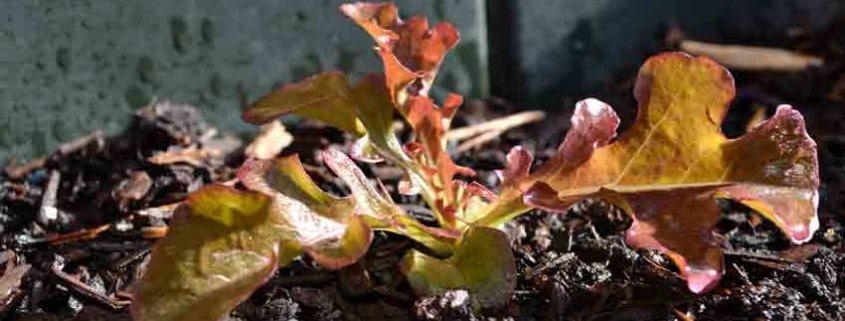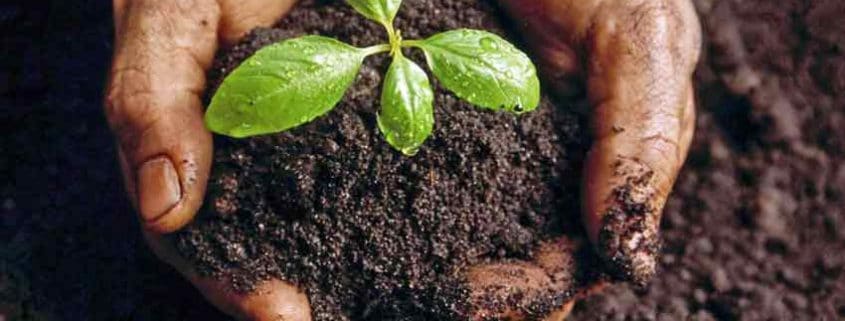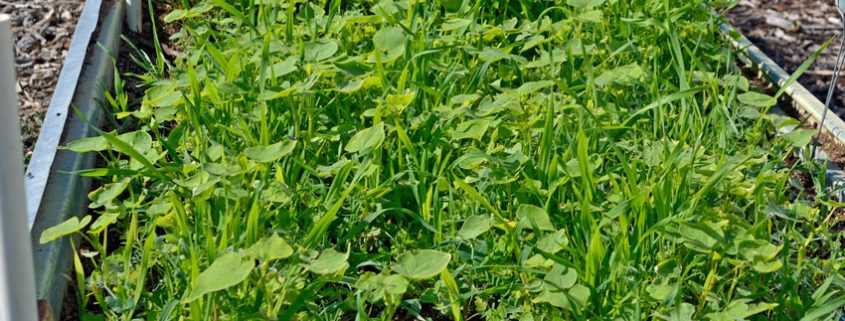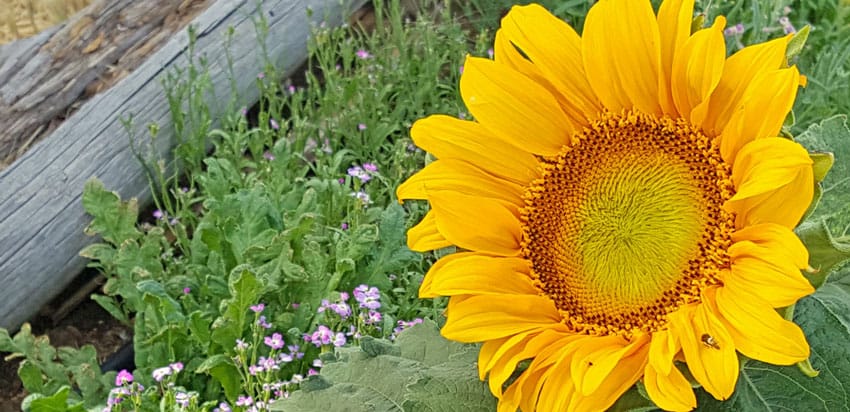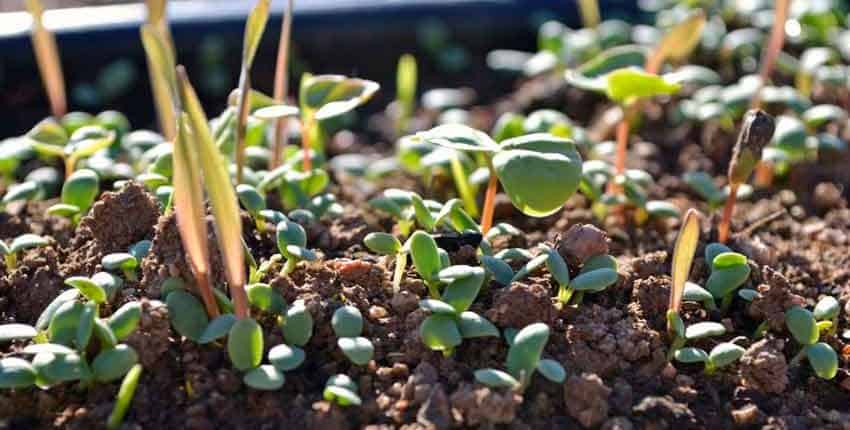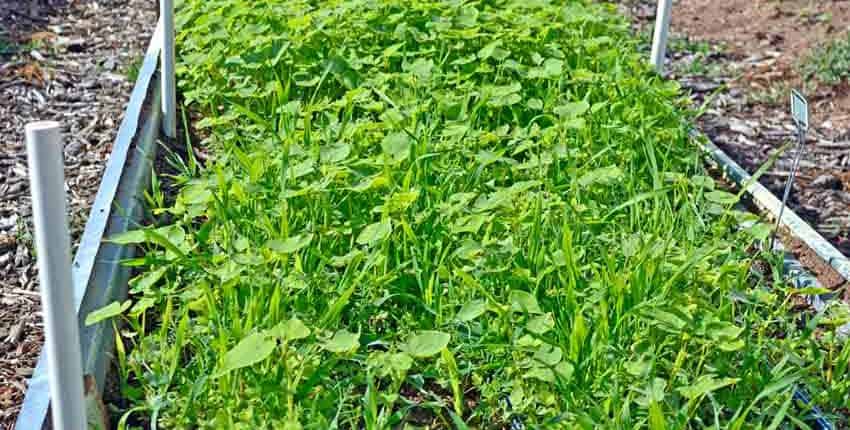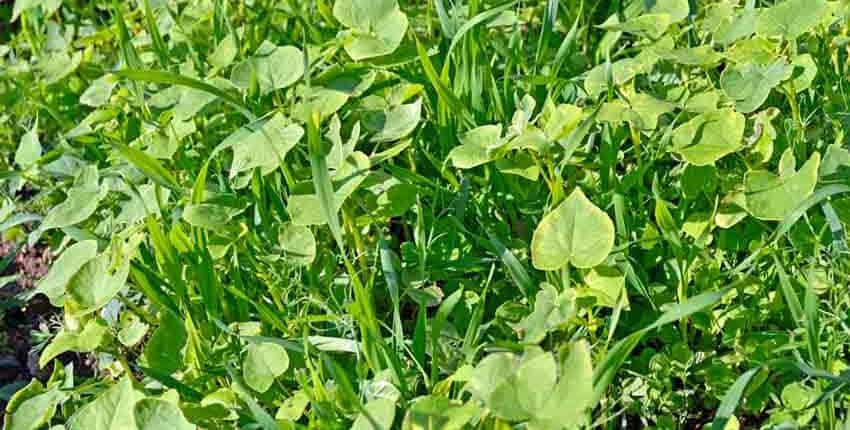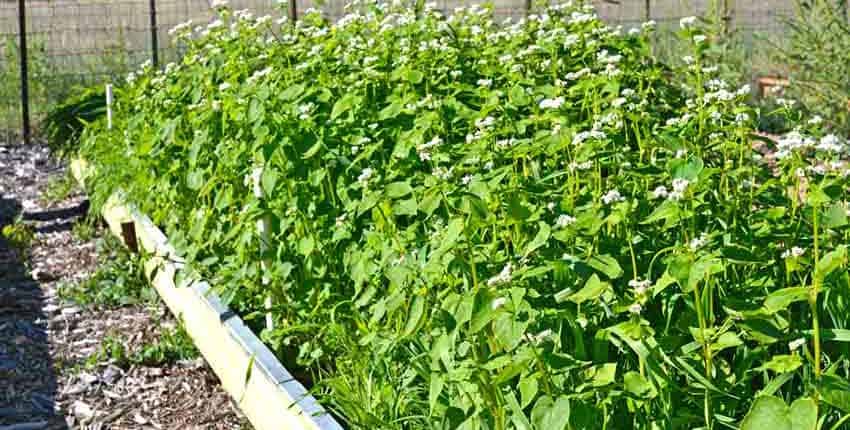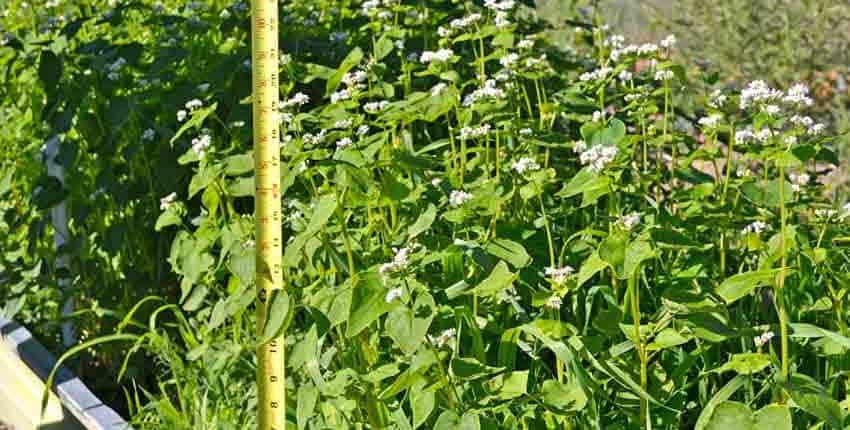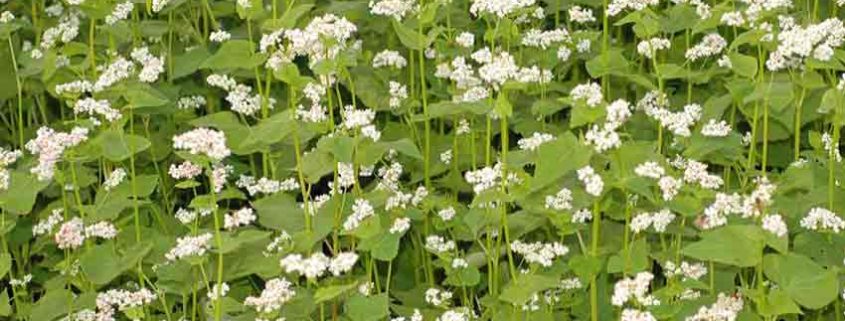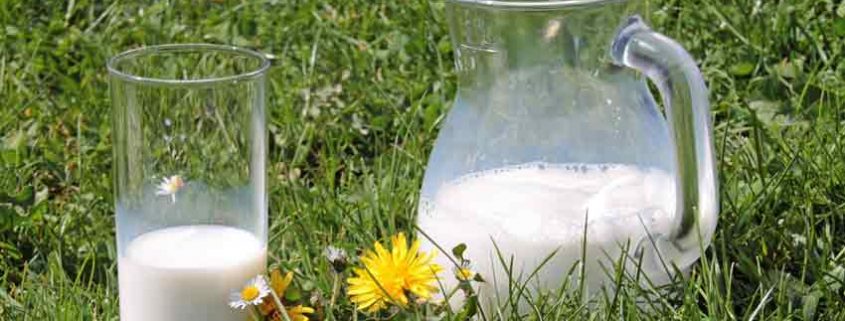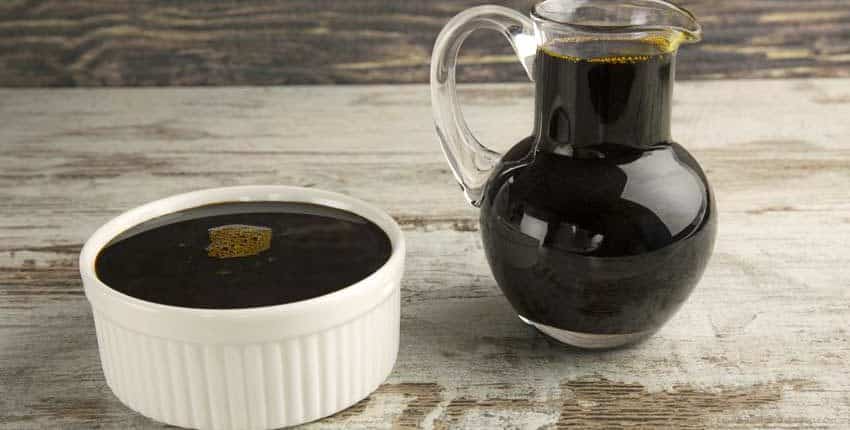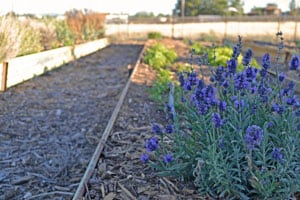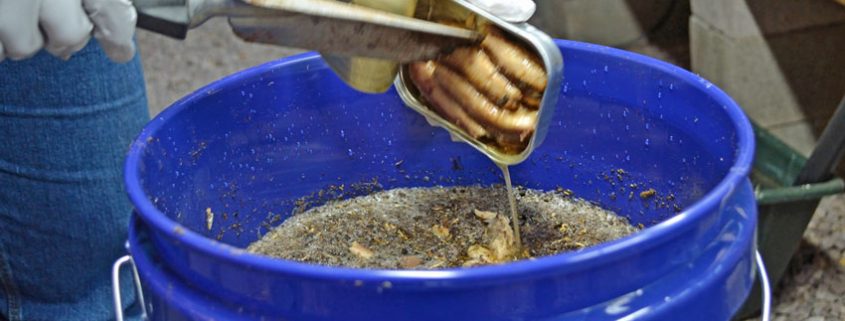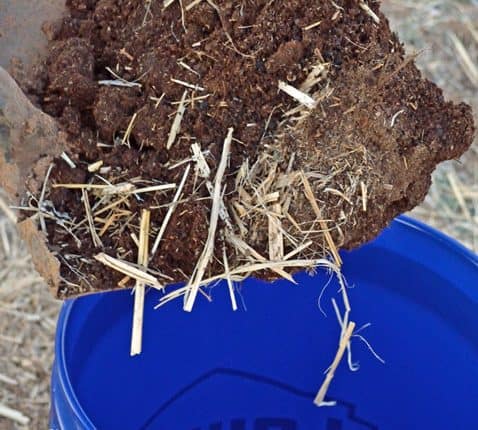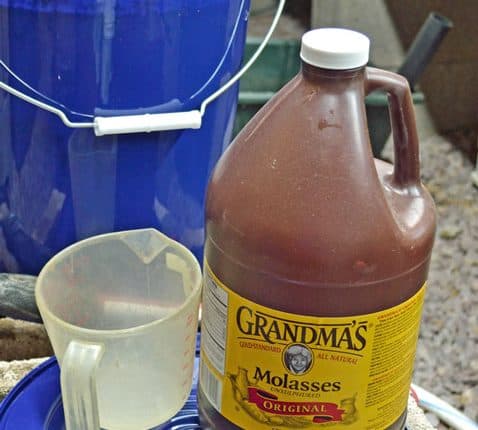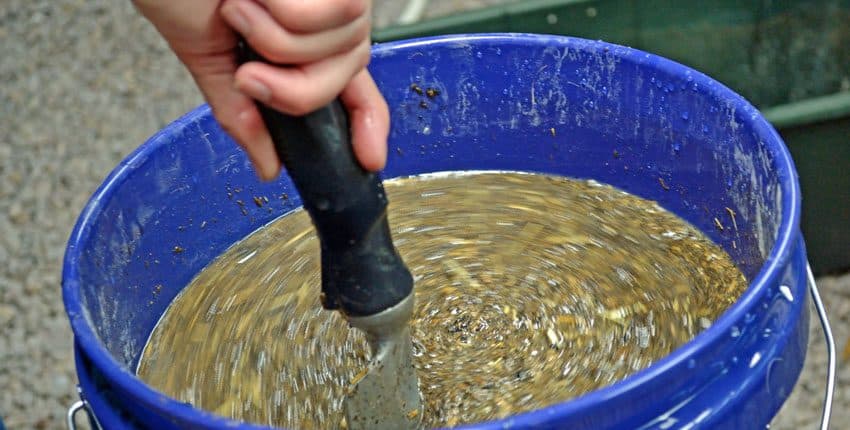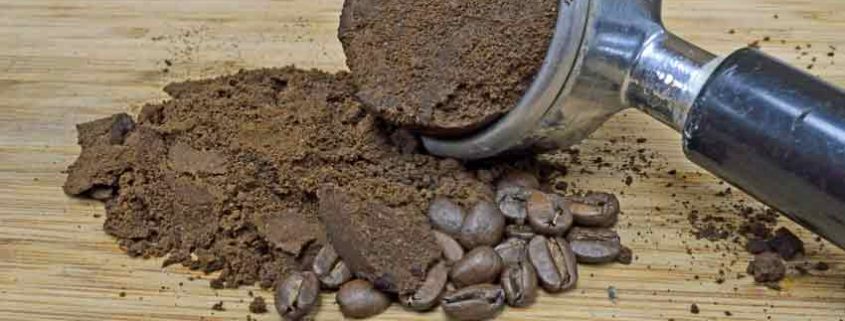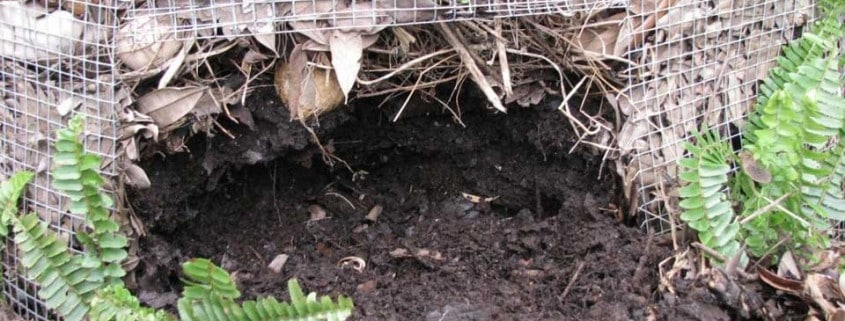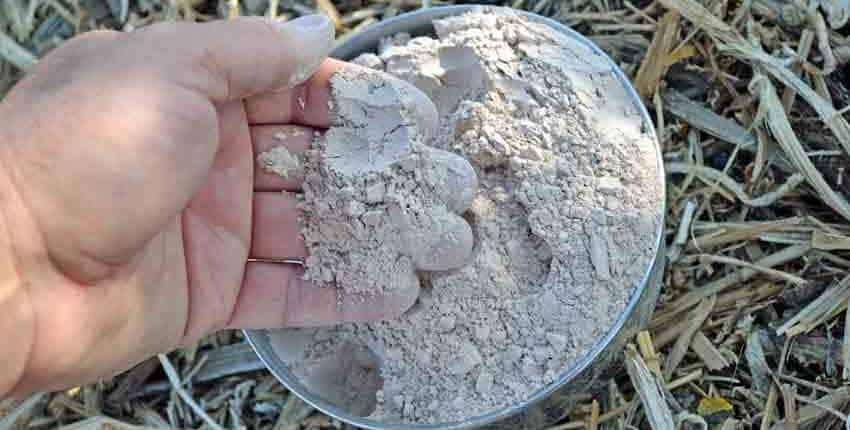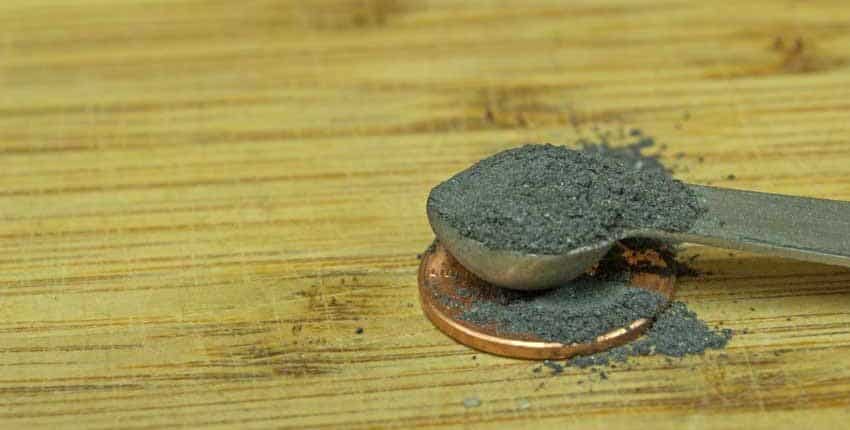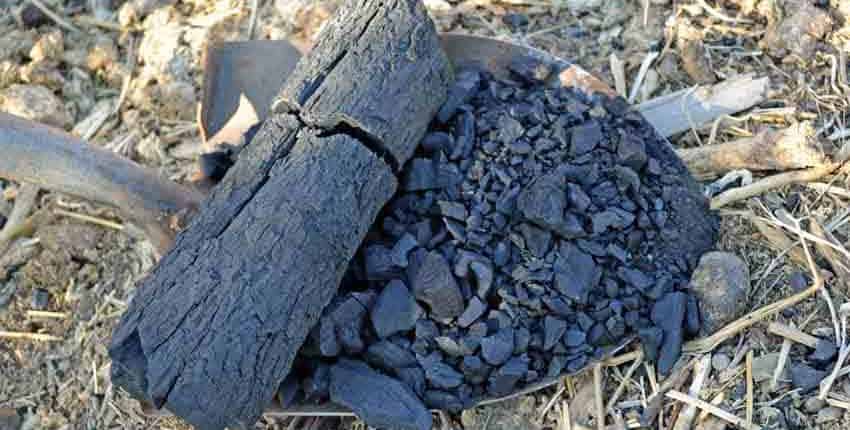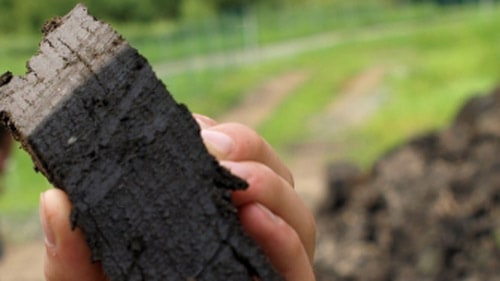Discover the importance of soil health for thriving gardens. Shift your focus and partner with nature for better results.
Learn how to work with your soil’s natural processes – protecting it, feeding its living workforce, minimizing disturbance, increasing plant diversity, and watering thoughtfully – to create the foundation for truly flavorful harvests and a more resilient garden with less work.
Discover the power of cover crops for easy soil improvement in your garden. Enhance soil health, suppress weeds, and attract beneficial insects with these natural helpers.
Cover Crops Boost Fertility While Beating Weeds
Historically, our soils were developed through the interaction of diverse plant and biology growth but much of this has been lost through large scale commercial agriculture becoming increasingly dependent on chemicals to feed the plants, instead of the soil and its organisms. This “trickle-down” effect has also affected home gardeners and small scale growers, and now we struggle to find ways to bring that plant diversity back to the garden.
Planting a multi-species cover crop in your garden will greatly stimulate the soil life and biology while suppressing weeds, interrupting disease cycles and even supply nutrients for next season’s crops.
We spend a significant amount of time teaching straightforward ways home gardeners can improve their soil, so we are often asked: “How can I manage pest and disease issues in my garden?” The simplest answer is: “Improve your soil.” Immediately followed by: “Plant a cover crop.”
The next question we hear is usually: “How will that help my pest and disease issues?”
Let’s take a closer look, and remember that a diverse cover crop mix can accomplish several of these at once.
We’ll start with a few of our customers’ gardens and let them tell you about their experiences in their own words! Then, we’ll explain how and why planting a cover crop in your garden this season will boost your soil’s fertility.
Crimson Clover

Tomatoes with Crimson Clover cover crop. A perfect illustration of the “no bare soil” concept.
“Experimented in one of my six raised beds (4’W x 16’L) and was very happy with virtually no weeds. Plan to use this as a between plantings cover crop going forward!!”
– Skipper
“I needed a ground cover that would improve my really bad soil and offer the disappearing bees and pollinators a refreshment stand. As usual, Terroir filled the bill. I planted these seeds in several different locations and they sprouted and grew in every one of them – from crushed granite mixed with sandy soil to soil that had been covered for YEARS by heavy green plastic. Full sun, partial shade – it made no difference. They thrived.
And two days ago they started to bloom AND I saw three honey bees land on them. “
– Karen
Garden Cover Up Mix
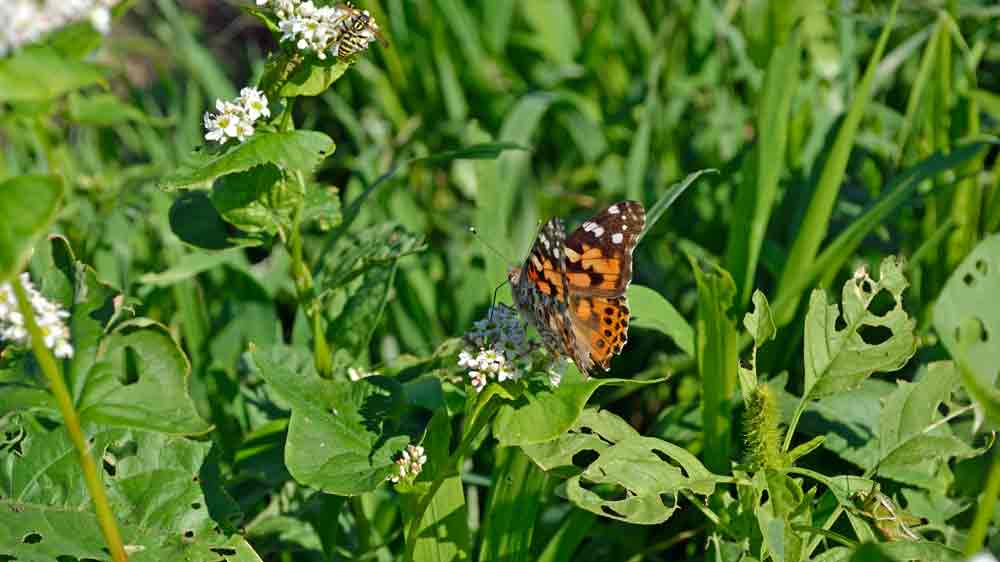
“Germination was excellent. I have a beautiful cover crop that the bees are totally enjoying. This mix has been the easiest cover crop I have ever planted, no fuss, very little upkeep, just add a little moisture. It’s so magnificent I spend 5-10 minutes every day just enjoying it.”
– Linda
“I’ve grown vegetables in my 4 4’x12′ raised beds for over 25 year, renewing the soil annually with a layer of compost; yields had become just OK. Two autumns ago I planted the Cover Up Mix, turned it into the soil in spring, covered the beds with the usual compost; happily report last year’s yields were up appreciably. The garden was positively lush (an unusual state in our high desert environment with 2017’s prolonged high summer heat). So I planted your cover crop mix again last fall and am looking forward to this year’s results. Definitely recommend!”
– Kerry
“First time I’ve used a cover crop; planted 6 weeks ago in 1/2 of my garden because the other half was still producing. Easy to plant, grew quickly with great coverage. The best part is that everywhere the cover crop was planted there are NO WEEDS! Morning glory has been my biggest problem and I have none where I planted the cover crop. Seeing the comparison between the two halves has made me a believer… already re-ordered enough for the whole garden for next year, and plan on using it in my flower beds, too. Highly recommend!”
– Pamela
Soil Builder Mix
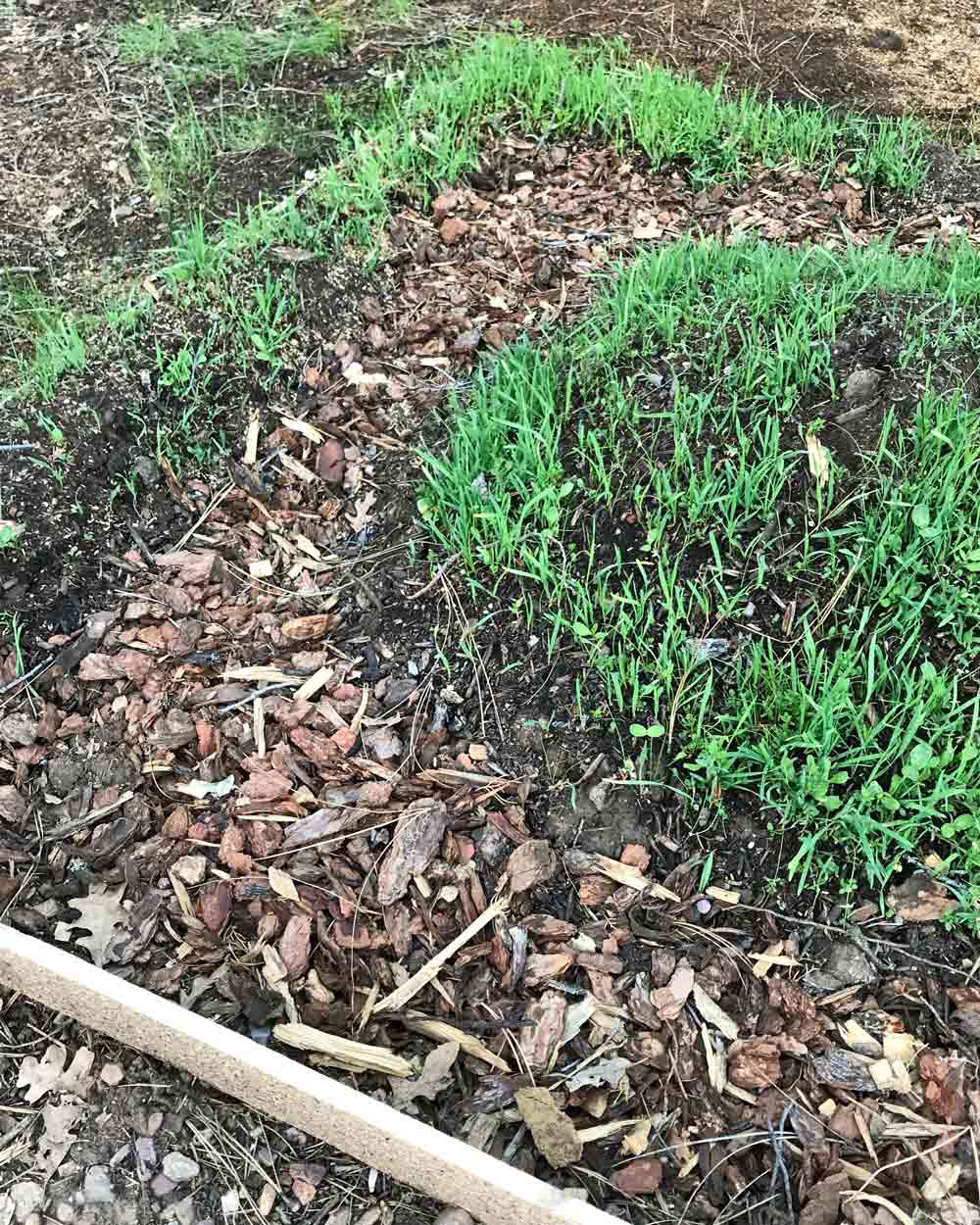
“Great germination, fast early growth and very thick. Really looking forward to better soil.”
– Victoria
“I love this! It is growing so healthy and lush. I love the great variety of plants in it. It will get turned in as a green manure day after tomorrow and I am so looking forward to reaping the benefits!”
– Donna
How and Why Cover Crops Work

Suppress Weeds
The best way to suppress weeds is with a highly competitive crop that quickly forms a canopy and shades weeds out. Summer annual cover crops like buckwheat and crimson clover form tight, dense canopies and will often outgrow many weeds. A diverse mixture of cover crops like our Garden Cover Up Mix – which includes both buckwheat and crimson clover – is much more weed-competitive than a single species.
Reduce Weeds in Next Year’s Garden
Planted in late summer or early fall as part of our Garden Cover Up mix, cereal rye is one of the best weed-suppressing tools if your next crop in that bed will be a legume like beans, chickpeas, lentils, peas, or soybeans as it aggressively ties up nitrogen – leaving little for weeds to use.
The legumes don’t mind, as they just fix their own nitrogen.
If your next crop is nitrogen demanding like corn or green leafy vegetables, a fall legume like hairy vetch can be used to both produce nitrogen and suppress weeds. Vetch does make nitrogen, but when it is cut or frost-killed the nitrogen is a protein and must decompose before it is available to either crop or weeds.
Both rye and hairy vetch form a thick mulch when cut that helps suppress small-seeded weeds like Palmer amaranth – better known as pigweed – by starving them of sunlight after germination so they run out of energy. Both rye and vetch produce biochemical compounds that stunt weed growth, called allelopathy.

Fix Nitrogen
This is best accomplished with a diverse mix dominated by legumes like our Garden Cover Up Mix. Remember, mixtures are capable of fixing much more nitrogen in a more stable and plant-useable form than single-species cover crops alone.

Build Soil Organic Matter
As gardeners, this should be our very first priority.
As we have learned more about how soil organic matter is formed, we have come to realize the most important contributor to soil organic matter happens in the root zone through what is known as root exudates – biologically active compounds deposited into the soil through the roots – and not simply the aboveground plant growth as previously thought.
Therefore, the best and fastest way to dramatically improve your soil health and fertility is through significantly increasing root growth of a diversity of species and plant families, along with as much aboveground biomass as possible.
Diversity of plant families makes for a more nutritious diet for the soil organisms that build organic matter in the soil, as some species have root exudates high in sugar, others high in protein, others high in lipids, while others are high in minerals; when combined, it makes a more complex and balanced diet than a single cover crop can provide. In general, since the production of root exudates depend on the level of photosynthesis, the more biomass a plant produces, the higher the root exudates and the faster you build soil organic matter.
To Really Build Soil Organic Matter
Inoculate your first planting with our mycorrhizal fungi – MycoGrow. Mycorrhizal fungi form mutually beneficial relationships with plant roots, extending their reach and monitoring nearby soil nutrients, feeding needed nutrients that are otherwise out of reach of the plant roots.
The soil proteins – called glomalin – produced by the mycorrhizal hyphae is the most persistent form of organic matter known and does wonders for the soil.
Now It’s Your Turn
Hopefully, you have a much better understanding of why and how cover crops can make a big positive difference in your garden, no matter if you have a traditional row garden, raised beds, or large containers. If you have soil, cover crops will improve it!
We’ve watched the skepticism on people’s faces when we talk about the multiple benefits of using cover crops in their garden, but then when they try them, the skeptical looks turn to astonishment when they describe how much better their gardens performed.
Help Us Help You
Did this help you understand cover crops better? Do you know a gardening friend who could use this information in their garden?
Please share this with your friends – either with the buttons below or on your social network of choice.
Soil Elixir Jump-Starts Your Garden’s Soil
One of the most anticipated times of year for gardeners is Spring, with the attendant planting season. Everything is new and fresh, a chance to start over and improve on last year’s garden. A big subject for gardeners is what to do with the soil to prepare it for planting. If you have been reading our articles over the past several years, you know we advocate building the health and vitality of the soil in a natural, biologically safe manner. Soil becomes healthier, more productive, and disease, weed, and pest resistant. It results in an upward spiral where the garden gets better year after year.
Here is a unique recipe for a spring garden elixir that is easy to mix, completely non-toxic, and hugely beneficial for jump-starting your garden’s soil and getting it ready for planting. It comes courtesy of Crop Services International, which has over 35 years of experience helping growers accomplish their goals. They provide a Non-Toxic/Biological/Sustainable approach to growing food, from a full-scale commercial farm to the home gardener. We have read “The Non-Toxic Farming Handbook,” which they wrote to educate ourselves on improving our knowledge and approach.
This recipe is based on a 20′ x 50′ garden or 1000 sq. ft. Adjust for your garden size.
Before You Start
This recipe and applications assume an average garden soil that is basically good but could use some help.
It works in fertile soils by subtracting the lime or gypsum application, adding compost before spraying the elixir.
It helps very poor soils, but won’t give as much effect.
Preparing your garden beds for the elixir will require a couple of things.
First, evenly spread a 50 lb bag of high calcium lime (for acidic soils) or gypsum (for alkaline soils) across your beds. Your local garden center should have this. If using lime, it should be high calcium lime with as low magnesium as possible. 5% or less is great, up to 10% is acceptable, but nothing over 10%. The higher magnesium percentage releases excess nitrogen into your soil, greatly decreasing its fertility. It also overloads both the chemical and biological processes of your soil. Do not buy Dolomite lime, as it has too much magnesium.
Then, follow with 100 lbs of rich, aged compost, spread evenly across your beds, about 2 full-sized wheelbarrows. This can be purchased or from your own compost pile. Again, the best is made by you, and it is easy – “Compost – Nourishing Your Garden Soil” has all the details.
After doing both of these, make and apply the elixir.
Notes on Ingredients
- When purchasing the fish fertilizer, if you can find one with kelp or seaweed, even better. If you want the absolute best fish emulsion possible, brew your own! Read our “Best Homemade Fish Emulsion” for the recipe and instructions.
- Blackstrap molasses is best for its increased mineral content. Unsulphured is preferred but not absolutely necessary. One of the best sources of inexpensive molasses is a feed store that supplies horses, which can be bought by the gallon for much less than at a supermarket.
- Do not buy diet cola, as the Aspartame/NutriSweet used as the sweetener acts as a chelating agent, meaning it ties up the minerals and nutrients in the soil, making them unavailable to the plants. (It also does the same thing in your body!) The cola has Phosphorus to add to the mix along with sugars.
- The beer adds B vitamins – no, not vitamin Beer!
- The Borax powder adds Boron, one of the most important elements in the biochemical sequence of plant growth.
- Cranberry juice is full of vitamins and minerals, acts as an antibacterial agent, and has an acidic pH. Depending on how the juice is processed, it can also contain significant amino acids.
This recipe is based on a 20′ x 50′ garden or 1000 sq. ft. Adjust for your garden size.
- 20-24 oz liquid fish fertilizer Home-made is best
- 1/2 cup molasses Black strap has more nutrients
- 16 oz bottle of cola – NOT DIET!
- 24 oz beer 2 - 12 oz cans, any beer works
- 1/2 cup Borax powder
- 1 qt cranberry juice – make sure to get 100% cranberry juice, not a dilution
- Mix well with a stirrer and thin with enough water to enable mixture to be sprayed with a tank type or hose-end sprayer.
Apply the mix evenly over lime or gypsum and compost base with sprayer. If needed, go back over with second application to use up all of the batch, just make sure to apply evenly.
Broad-fork or lightly rototill garden soil. If using a rototiller, don’t go more than 2 inches deep at the maximum. Most of the biological growth happens at the 2-3 inch mark and the soil is turned over an inch or so beyond what the tines reach. Tilling deeper only destroys microbial life in the soil, setting you back in your efforts to create and build biologically active soil.
It must be noted that the sprayer cannot have been used to spray any chemical treatments like herbicides, pesticides, etc. as this will put those chemicals onto your soil, killing the microbial life in the soil and feeding the chemicals to the plants, where you wind up eating them!
Seed Planting Elixir
Once you have applied the elixir and broad-forked or lightly tilled the soil, prepare your garden planning and seedlings. We have another planting elixir to use just after planting the seeds and transplanting the seedlings into the garden that we’ll share with you: In a gallon milk jug, mix 1/2 cup of fish emulsion, 1 tsp sugar (preferably raw or brown), and 1/2 cup of cola. Fill the jug with water and shake well. Apply the mixture over the seeds and transplants. Each gallon will treat approximately a 50-foot row.
This is a great start towards sustainable, biological agriculture in your own garden. Remember, though, it is just a start, a good step in the right direction. To continue to make progress in knowledge and soil health, you need to find out where you are starting from. Do more reading, ask questions, and get a complete soil analysis, not just the widely offered NPK and pH soil tests. Spend the money to find out exactly where your garden soil is, and then you can make sound decisions on where you want and need to go. Then you won’t be guessing and shooting in the dark, trying to do what is right but not really knowing if you are making positive progress.
A Universe in Your Hand
In a handful of soil from your garden, you hold potentially billions of different living organisms hard at work making your soil a better place for your plants to live. Most of these team players are microscopic – too small to see with the eye, but a few are large enough to observe. Bacteria, fungi, mycorrhizae, protozoa and possibly algae are on the microscopic side while earthworms, pillbugs, arthropods and some nematodes are big enough to see in your hand.
We pay lots of attention to improving soil, for good reason. Healthy, fertile soil grows stronger, healthier, more productive plants while reducing insect and disease damages. You see and taste the difference in richer, brighter colors and sweeter or more flavorful vegetables and fruits.
Most attention focuses on the structure and chemistry of the soil – is the soil made up of sand, loam, clay or some mixture? The chemistry shows what nutrients are present and in what amounts. This is the common approach but leaves out one of the biggest components of soil improvement – the biological community.
It’s easy to overlook them because they can’t easily be measured – like determining soil structure or reading a soil analysis for nutrient deficiency.
There’s a saying among soil consultants that,”You must build a house for the biology.” That means that soil structure and chemistry must be aligned before the beneficial organisms can fully go to work. It also recognizes the critical but often overlooked role they play. Beneficial soil organisms release tied up nutrients in the soil and move them into the reach of plant roots, improve soil structure and increase nutrient retention, among many other things.
Now that you understand a bit more about them, let’s introduce you to your team!
The Big Boys
Starting with the larger, more visible players-
Earthworms – An acre of good garden soil can have between 2 and 3 million of these black gold producing workers, constantly processing organic matter into readily available nutrients your plants absolutely love.
That means each square foot of good soil in your garden can have up to 45 – 70 earthworms. You won’t be able to see all of them, as they can range a few feet deep.
Arthropods – are ants, mites, and springtails who voracious shred decomposing plant leaves, stems, and mulch. They do the heavy lifting, getting the plant organic matter into bite-sized pieces for the smaller team members.
Pillbugs– are land-based crustaceans, distant cousins to lobsters, crabs, and shrimp. They are scavengers, mainly feeding on moist, decaying plant materials – very useful in shredding dead plant matter so it can be fully decomposed.
If you see these guys in your handful of soil or in your garden, you are doing several things right. They won’t stick around in dead soil with little or no organic matter, or in soils that are heavily contaminated with pesticides.
The Little Guys
Now, on to the smaller and less visible players that are no less important –
Fungi – More common in woodland soils or in areas where woodchips have been laid down. They can appear as mushrooms with stems and caps – especially after a rain – but are more often seen as a whitish growth on moist and decomposing parts of the woody material. They send out hyphae or long, thin strands to decompose organic materials, transport nutrients, and improve soil structure while stabilizing it.
Protozoa – Single-celled animals that are always busily feeding on bacteria, soluble organic matter, and sometimes fungi. As the feed, they release nitrogen that is used by plant roots and other players on the team.
Actinomycetes – (pronounced act-in-o-my-seetees), are special beneficial bacteria that are responsible for the rich, earthy smell of freshly turned soil. Their specialty is digesting the high carbon cellulose in wood and the chitin of shed pillbug shells and insect bodies.
Beneficial bacteria – These microorganisms are more common in the nutrient-rich garden soils, forming associations with annual vegetables and grasses.
Beneficial nematodes – Not all nematodes are destructive, and these guys search out, infect, and kill targeted destructive insects. Different nematode species attack different pests.
Mycorrhizae – A very specialized fungi that bond with the tiny, hair-like roots of plants in a mutually beneficial relationship. The fungi send out hyphae into the soil to bring back specific nutrients needed by the plant, in return for a sugar-based plant sap that feeds the mycorrhizae. In essence, they feed each other what they can’t get for themselves. Mycorrhizae can only survive on living plant roots, and about 95% of our garden plants depend on their fungi friends to thrive.
Help Your Team Out
Now that you’ve met the team working tirelessly for you in the garden, help them out with making sure they’ve got food, water, and shelter – which compost provides almost everything for them!
When you hear someone talk about “beneficial soil organisms“, you will know exactly what they mean!
Soil Builder vs Garden Cover Up Mix – which is best for your garden?
Both of our cover crop mixes give you multiple benefits in the soil and above it. You can’t go wrong with either one. The Garden Cover Up mix is a general use cover crop, while the Soil Builder mix is more specific toward improving the overall condition of your soil.
Cover crops improve soil in a number of ways. They protect against erosion while increasing organic matter and catch nutrients before they can leach out of the soil. Legumes add nitrogen to the soil. Their roots help unlock nutrients, converting them to more available forms. Cover crops provide habitat or food source for important soil organisms, break up compacted soil layers, help dry out wet soils and maintain soil moisture in arid climates.
It’s always a good idea to maintain year-round soil cover whenever possible, and cover crops are the best way.
Let’s look at how cover crops work overall, then we’ll see the differences of each mix.
Most cover crop mixes are legumes and grains or grasses. Each one has a different benefit to the soil. Legumes include alfalfa, clover, peas, beans, lentils, soybeans and peanuts. Well-known grains are wheat, rye, barley and oats which are used as grasses for animal forage.
Legumes
Legumes help reduce or prevent erosion, produce biomass, suppress weeds and add organic matter to the soil. They also attract beneficial insects, but are most well-known for fixing nitrogen from the air into the soil in a plant-friendly form. They are generally lower in carbon and higher in nitrogen than grasses, so they break down faster releasing their nutrients sooner. Weed control may not last as long as an equivalent amount of grass residue. Legumes do not increase soil organic matter as much as grains or grasses. Their ground cover makes for good weed control, as well as benefiting other cover crops.
Grains or grasses
Grain or grass cover crops help retain nutrients–especially nitrogen–left over from a previous crop, reduce or prevent erosion and suppress weeds. They produce large amounts of mulch residue and add organic matter above and below the soil, reducing erosion and suppressing weeds. They are higher in carbon than legumes, breaking down slower resulting in longer-lasting mulch residue. This releases the nutrients over a longer time, complementing the faster-acting release of the legumes.
This pretty well describes what our Garden Cover Up mix does, as it is made up of 70% legumes and 30% grasses.
Our Soil Builder mix takes this approach a couple of steps further in the soil improvement direction with the addition of several varieties known for their benefits to the soil structure, micro-organisms or overall fertility.
For example, the mung bean is a legume used for nitrogen fixation and improving the mycorrhizal populations, which increase the amount of nutrients available to each plant through its roots.
Sunflowers are renowned for their prolific root systems and ability to soak up residual nutrients out of reach for other commonly used covers or crops. The bright colors attract pollinators and beneficials such as bees, damsel bugs, lacewings, hoverflies, minute pirate bugs, and non-stinging parasitic wasps.
Safflower has an exceptionally deep taproot reaching down 8-10 feet, breaking up hard pans, encouraging water and air movement into the soil and scavenging nutrients from depths unreachable to most crops. It does all of this while being resistant to all root lesion nematodes. Gardeners growing safflower usually see low pest pressure and an increase in beneficials such as spiders, ladybugs and lacewings.
Now you see why you can’t go wrong in choosing one of our cover crop mixes! Both greatly increase the health and fertility of the soil, along with above-ground improvements in a short time. Even if you only have a month, the Garden Cover Up mix will impress you for the next planting season.
For a general approach with soils that need a boost but are still producing well, the Garden Cover Up mix is the best choice. Our Soil Builder mix is for rejuvenating a dormant bed or giving some intensive care to a soil that has struggled lately. Both will give you a serious head start in establishing a new growing area, whether it is for trees, shrubs, flowers, herbs or vegetables.
Let one of our cover crops go to bat for you and see what happens when you play on Mother Nature’s team!
Can cover crops improve garden soil in one month?
Cover crops – also called green manures – have improved soil for thousands of years. 3,000 years ago Chinese agriculture began planting horsebeans and sesame for soil improvement. Much later the Greeks and Romans sowed special crops to increase soil fertility.
The past 60 – 80 years has seen an incredible amount of knowledge emerge from small farmers experimenting with planting different cover crops and learning from what resulted. This knowledge was built on a foundation of several hundred years of European trial and error.
We now have access to detailed information about how to use cover crops for the maximum benefits in our gardens, pastures and fields.
Our Garden Cover Up Mix was developed from research into the specific benefits we wanted to bring to the home garden soil, as well as what species supported each other.
This photo essay is a look at what one month – 4 weeks – of growth provides in an average raised bed.
After sowing we began watering with our drip system, but the monsoon rains provided a good amount of water over the month. This helped the plant growth along, so your results may be a week or two behind these photos.
Week One
At one week, the mix has almost all sprouted and shown vigorous growth. The oats and rye are shooting up, looking like grass while the buckwheat spreads its leaves and the clover hugs the soil. The peas were just beginning to show up, as they took a few days longer to absorb moisture and begin germinating.
We planted the different parts of the mix separately to get an idea of how they grew by themselves and with other species in support.
The rye and oats both shot up rapidly, germinating within 3 – 4 days and showing good soil coverage.
The crimson clover was also up fast, creating a fluffy green blanket over the soil with its tiny green leaves. Even with only an inch of growth it was easy to feel the temperature differences between the tops of the leaves and the soil temperature – it felt like 15°F difference!
The buckwheat was a couple of days slower coming up than the oats or rye. Once the sprouts appeared they immediately opened their leaves and really started growing.
Week Three
After three weeks the mix has almost completely covered the raised bed. The root system is about 3/4 of the top growth at this point, so the root density below the soil is almost as much as seen here. This is why cover crops are so beneficial to soil fertility.
A closer look shows how much shade the soil has and how thick the mix is growing. This out-competes most weeds above the soil while the roots choke out weeds below.
The young seedlings have just finished emitting auxins, a natural root hormone that inhibits other seeds from growing.
This mechanism gives the cover crops a head start over any other weeds for the next 2 – 3 weeks. When weed seeds can’t germinate, they will often rot as the soil fertility improves.
Week Four
The growth accelerated going into the fourth week, as these photos show. The white PVC stake is about 14 inches tall. Last week the growth was about 3 – 4 inches, but this week it shot up above the top of the stake.
Besides putting on a lot of height, the mix also completely filled in the raised bed. Weeds have no space to grow and we could only find one or two after searching for them.
The soil is much cooler than the surface of the leaves. It is also moister, but that could be due to the amount of recent rains and not the cover crop. The buckwheat is starting to bloom and is attracting bees as seen in the top photo detail.
The buckwheat is the tallest of the mix at about 21 inches tall. The mix is extremely full and thick up to about 16 inches, completely choking out any weeds. The root system is still about 3/4 of the height of the plants, so there is an amazing amount of roots below ground! This shows why planting cover crops does so much to improve the physical structure of the soil.
As the roots die and decay they add organic matter to the soil, open up moisture and air pathways where the roots grew and increase the carbon content – all at the same time!
Pretty good for a few minutes spent planting the seeds and a months’ worth of growth!
Both the rye and oats look like really lush grass. They completely cover the soil and top out at just over 15 inches at one month. We couldn’t find any weeds in this test plot.
Looking closer at the density of the rye planting, it is easy to see why weeds don’t stand a chance. There is no room for anything other than the rye with this dense seeding rate, which is the point.
Next Steps
If a killing frost happened tomorrow there is enough growth to create an excellent mulch while the root system will feed the soil and its microbial populations.
Our first frost is still several weeks off so the cover crops will keep growing both above and below the soil level. The flowers need watching to prevent setting seed and creating another crop next season. We will clip or mow the flower heads as they develop if there isn’t a frost soon enough.
If the rest of the mix can develop before mowing or a killing frost, it gives more nutrition and benefits to the garden bed.
Cover crops will increase the bio-available nutrition in your soil for next season, even if you use a well-aged compost. Both approaches have benefits but if used together support each other and create a better, more fertile soil sooner than if only one is used.
You don’t need a lot of time to grow a good cover crop and seriously improve your garden soil – a month will do! Even if you only have 2 – 3 weeks you will be better off with a shorter planting than none at all.
Go plant some cover crops. Your garden will reward you handsomely next season!
Cover Crops Q & A
Our cover crop mix has generated lots of questions on how to use it. This means we need to share more information with you. It is fantastic seeing so much interest about improving your soil and your garden!
I’ve taken the most frequent questions and condensed them into a Q&A format below.
“I want to order cover crop seed. I don’t know how much I need, how to prepare the garden before sowing the seeds and when to plant it.”
The Garden Cover Up mix page lists the coverage rates for each variety.
1 lb will seed 200 square feet, or a 10×20 garden bed or 2 5×10 beds. 8 oz will seed 100 square feet, or a 10×10 garden bed. This gives you a thick planting, boosting soil fertility and decreasing weed pressures.
Ideal planting times are early August through mid-September, depending on your growing season. Plant around mature garden vegetables or in spaces left from the removal of older plants.
Preparation is easy. Broadcast the seeds and rake them into the top half inch of moist soil, or cover with 1/2 inch of mulch or compost. Water equal to 1 inch of rainfall per week until seedlings become established.
The best time to plant is 6 – 8 weeks before your first frost date. If you don’t know your expected first frost date, use the First and Last Frost Dates tool from the National Garden Association.
Enter your ZIP code and find the weather station closest to you.
The first frost date is the intersection of the vertical 50% column and horizontal Fall 32°F line.
Count back 6 to 8 weeks to determine when you should sow the cover crop seed. By planting a few weeks early you’ll have bigger growth, but may need to clip the spent flowers to prevent re-seeding.
“Can/should cover crops be used in raised beds? Approx 3-4′ X 6-8′. Do they need to be turned in the spring? Do they go to seed and become intrusive?”
Cover crops are good for any sized garden larger than a container garden where it is easier to change the soil out. Your raised beds would benefit from our cover crop mix.
If you get a good freeze, the mix will “winterkill”, meaning they will die after a hard frost of around 24°F or so. Then the plant matter will fall down to become mulch for the soil, while the roots decompose. You can turn them under, but I don’t recommend it as tilling or turning disturbs the soil structure. You can plant right among the mulch in the spring.
The cover crops will set seed and scatter those seeds if you let them. Plant cover crops 6 – 8 weeks before the first frost so they get good growth and flower but usually don’t have the chance to set seed. If you see seed forming, just clip those seed heads off and throw them away.
This way the cover crop can’t be an unwanted guest next spring!
“I would like to start a cover crop on a small portion of my property and put in a garden next year. What do I have to do to prepare the soil to put in a cover crop. Also, when do I turn over the cover crop?”
You have a great thought in using the cover crops to help establish and improve the garden soil for next season.
This is the exact method used by organic farmers and growers to prepare fallow soil for a crop. Growers will plant cover crops in succession, or they allow the flowers to re-seed themselves.
Rake to loosen the top inch or so, broadcast the cover crop seed and rake again until just covered. Water the area equal to 1 inch of water per week until the seeds sprout and the plants establish themselves.
Let the plants flower and start setting seed, then clip the heads to prevent them from re-seeding. Allow the plant matter to die in the frost, creating its own mulch. The roots and topsoil mulch decompose over the winter, giving you with an excellent start to next gardening season!
“I am slowly working toward taking my area back from prairie dogs and building a garden plot on 4 acres that are usually dry and sandy. Do you have a general ground cover seed mix to assist in soil health and holding my sand back from flowing away during the monsoon season?
I keep chickens with portable netting so something edible for them would be good.”
Our Garden Cover Up Mix provides plenty of nutritious forage for your chickens. Plant a test plot close to where they are. Water the area equal to 1 inch of water per week until the seeds sprout and the plants establish themselves. Then you can trim some as fodder for the chickens as it grows and develops.
Our Backyard Chickens collection is another option. It has a variety of tasty edibles like sunflower, corn, Swiss chard, mustard and kale.
For erosion control, I would plant a straight (50/50) mix of buckwheat and cereal oats. Both are fast growing with good root systems that hold the soil in place. They provide good mulch after the plant dies off. You might test plant a strip about 3 – 5 feet deep crosswise to how the water flows during monsoon season. This acts as a catch strip, slowing the water down and reducing the amount of soil moved. It also creates a berm for future moisture retention. The roots create a “sink” for the water flow which diverts the water into the soil and away from flowing across it. This starts to build up the shallow soil and water reserves on your property.
I would not mow or kill this planting but allow it to re-seed and establish itself well. If the test works, you can replicate this downstream of where the water flows as many times as needed.
Once the initial berm starts to form, plant the Garden Cover Up mix up stream. This takes advantage of the extra moisture to reclaim and build some good soil!
This will only take 2 or 3 seasons to establish some excellent berms fully and then you can plant more.
“I have celiac disease and therefore cannot be around wheat, and am also sensitive to oats. Do you have any other recommendations?”
Buckwheat is not related to wheat at all, as it is in the Rhubarb family – if you can believe that! You should not have any reaction to buckwheat. You can avoid the oats by ordering the individual cover crop varieties. The Crimson clover and hairy vetch are strong nitrogen fixers, where the Buckwheat and Rye are fast growing ground covers.
You can make your own mix by ordering the smaller amounts of the individual cover crops, avoiding what you are sensitive to.
“After the cover crop dies or you kill it – should you till it into the ground?”
The cover crop mix will die after a couple of hard frosts. It becomes a mulch insulating and protecting the soil over the winter. During that time the roots decompose and increase the soil fertility. Depending on your climate over the winter the mulch should almost dissappear by next spring’s planting time.
I don’t recommend tilling a cover crop, it disturbs the soil you spent the winter improving. When planting, open a small space in the mulch. Then it continues covering and protecting the soil while smothering weeds.
If you do feel the need to till, raise the tines to only till the top 2 – 3 inches of soil and don’t disturb deeper layers. This will work the decomposed vegetative matter into the soil where it will be used quickly.
The process is to plant a fall cover crop, let it die and overwinter to improve the soil. Next spring, plant another after the garden crops are in and up. This covers the soil and shades out most weeds. Repeat this cycle yearly and the soil becomes incredibly fertile after a year or so.
In fertile soil weeds aren’t as much of a problem because they just don’t germinate as well. Fewer weeds leads to fewer insects, as many insects “partner” with specific weeds for habitat or to lay eggs on. Increased soil fertility means healthier plants which do not attract predatory insects.
“I planted clover one fall as a cover crop, and found that in spring it had formed such a dense mat of roots I had to use a pickax, and it never DID die back in winter! (Living in a warmer winter climate.)
I have clay in my soil and have been amending it for several years now. Wouldn’t tilling the soil deeply (about 12 inches) be beneficial for breaking it up and making it more accessible to my garden plants’ root systems? It’s really solid and unfriendly down there in the root zone!”
Thanks for your question! That’s why you need to kill the cover crops manually if the weather doesn’t freeze cold enough to kill them. Mowing or weed-whacking is the easiest way to do this. Otherwise, the plants don’t die, the roots don’t decompose and you struggle to plant your garden.
If you kill the cover crops from late October to mid-November, they will benefit the soil!
There are a couple of ways to open up the soil, especially with a clay component.
1 – You can deep till the soil. Realize you are destroying many micro-organisms as you are completely changing where they live. This is ok once or maybe twice when first establishing the garden, but is detrimental to the soil health if done often.
2 – Use a broadfork or other mechanical means to open up the soil without disturbing the layers. This is often done by hand, so will only work in a smaller garden. Because you won’t be able to drill down deep in a hard soil, this might need to be done a few times over a couple of seasons.
3 – Plant cover crops or aggressive root crops such as sunflower, wheat, sesame or Daikon radishes which drill down and open up the soil. This isn’t a one time, fix-all solution, but with replanting in spring and fall the cover crops can continue building and improving the soil.
Do you know about the magic of milk and molasses in improving your garden? Yes, plain old milk of any kind – whole, 2%, raw, dried, skim, or nonfat – is a miracle in the garden for plants, soil, and compost. Molasses only boosts the benefits! Let’s see how and why they work.
Milk as Soil Food
Using milk on your compost and in your garden will probably come as a surprise to most.
Upon closer inspection, however, it starts to make sense. The amino acids, proteins, enzymes, and natural sugars that make milk a food for humans and animals are the same ingredients in nurturing healthy communities of microbes, fungi, and beneficial bacteria in your compost and garden soil.
Raw milk is the best, as it hasn’t been exposed to heat that alters the components in milk that provide the perfect food for the soil and plants, but any milk will provide nutrition and benefits. Using milk on crops and soils is another ancient technique that has been lost to large-scale modern industrial agriculture.
Milk is a research-proven fungicide and soft-bodied insecticide – insects have no pancreas to digest the milk sugars. Dr. Wagner Bettiol, a Brazilian research scientist, found that milk was effective in the treatment of powdery mildew on zucchini. His research was subsequently replicated by New Zealand melon growers who tested it against the leading commercially available chemical fungicide and found that milk out-performed everything else. Surprisingly, they also found that the milk worked as a foliar fertilizer, producing larger and tastier melons than the control group.
David Wetzel, a Nebraska farmer, completed a 10 year study on applying milk at different ratios to his pastures, and recorded the results with the help of a team made up of the local Agricultural Extension agent Terry Gompert , a university soil specialist, a weed specialist and an insect researcher.
What they found was amazing- the grass production was drastically increased; the soil porosity or ability to absorb air and water doubled; microbe activity and populations increased; cows were healthier and produced more milk on treated pastures; the brix or sugar level in the pasture tripled, indicating more nutrients were stored in the grass than before. Grasshoppers abandoned the treated pastures- the sugars are poison to destructive soft-bodied insects as they do not have a pancreas to process the sugars.
This also explains why damaging insects leave healthy, high-brix-level plants alone, as they contain more sugars than stressed and sickly ones. Read Milk Works As Fertilizer for the full article.
Home Gardener Recipe
For the home gardener, the ratio can range from 100% milk to a mixture of 20% milk to 80% water, with no loss of benefits.
Use as a spray on the compost and garden soil before planting and as needed when insects appear. Spray directly on the insects and around the areas they inhabit. When combined with molasses, it becomes a highly beneficial soil drench.
A proven solution is 20% milk – 1 cup of milk to 4 cups of water, or 2 cups of milk to 8 cups of water for larger gardens. Whatever amount you need, the 20% ratio has been proven to give the most effective results with the least amount of milk.
David Wetzel’s experiments found that 3 gallons of milk per acre benefits pasture grasses most, so the costs are minuscule compared to the benefits!
Molasses Feeds Micro-Organisms
Molasses is a viscous by-product of the processing of sugar cane or sugar beets into sugar.
Sulfured molasses is made from young sugar cane. Sulfur dioxide, which acts as a preservative, is added during the sugar extraction process. Unsulfured molasses is made from mature sugar cane, which does not require such treatment.
There are three grades of molasses: mild or Barbados, also known as first molasses; dark or second molasses; and blackstrap. The third boiling of the sugar syrup makes blackstrap molasses. The majority of sucrose from the original juice has been crystallized and removed. The calorie content of blackstrap molasses is still mostly from the small remaining sugar content. However, unlike refined sugars, they contain trace amounts of vitamins and significant amounts of several minerals.
Blackstrap molasses is a source of calcium, magnesium, potassium, and iron; one tablespoon provides up to 20% of the USDA daily value of each nutrient. Not only do these nutrients do a body good, they are highly valuable in building up the soil!
Molasses is a very valuable addition to the compost pile, as well as to the garden itself. Unsulfured blackstrap is the preferred variety due to the mineral content, but any of the unsulfured ones will do fine. The benefits beyond the minerals are the natural sugar content that will feed the microorganisms in the compost or soil of the garden.
More Gardening Recipes
Use 1/4 to 1/2 cup of molasses to a gallon of water and spray onto the compost pile or garden, or add to the drip system for the garden. For soils that are poor, stressed, or need help, use 1 cup; for those that need a little “snack, “use 1/4 cup. The readily available sugar content will skyrocket the microbial activity.
Apply once or twice a month, but be careful not to overdo it – don’t train the microbes to expect you to feed them, only give them a boost when they need it!
Blackstrap molasses is also commonly used in horticulture as a flower blooming and fruiting enhancer, particularly in organic hydroponics. Use the before mentioned mixture in the drip system, or sprayed alongside the roots of fruiting vegetables as they start to flower to increase their flowering and fruiting.
Add 3 Tablespoons of molasses to the milk spray solution mentioned above and use to feed plants during the height of growing season. Hungry, high production plants such as tomatoes, peppers, eggplant, melons, and such will really benefit from the consistent feedings, giving you more production that is more flavorful.
Sweet Weed Control
A fringe benefit of spraying the milk and molasses mixture on the garden is biologically friendly weed population control. Many broadleaf weeds thrive on diets high in available nitrates and potassium diets, common with commercial fertilizers. Phosphorus is “tied up” or bound with calcium in the soil and needs biological activity to release it. The calcium in milk helps to compensate for what is unavailable in the soil, while the increased biological activity from both the milk and molasses releases unavailable phosphorus and creates soil conditions that are unfavorable to the germination of weed seeds.
Minimal Costs
The costs of applying the milk and molasses mixture are minimal, but when compared to any other fertilizer and insecticide regimen – even those that are organic in nature – milk and molasses have no comparison.
For instance, one acre has 43,560 square feet, and a gallon is 128 oz.
Doing the math, we find that 3 gallons per acre is 0.003 of an ounce per square foot!
Assuming a gallon of organic milk costs $8.00, that works out to 0.00055 dollars per square foot or 0.055 cents per square foot! Yes, that is right – when rounded up, it is six-tenths of a penny per square foot of garden.
So if you had a large garden – say 1,000 square feet – one application of the milk would cost a whopping $0.55 (55 cents), plus the expense of 2 – 3 tablespoons of molasses. What other biologically friendly soil fertility improvements would cost this amount?
Here’s the proof of the math:
1 acre = 43,560 square feet (ft²)
1 gallon = 128 ounces
128 oz/43,560 ft² = 0.002938 oz/ft²
3 gallons x $8 = $24
$24/43,560 ft² = $0.00055/ft² multiply this by 100 for cents = 0.055 cents/ft²
Who knew that something as simple as milk and molasses had such powerfully positive, far-reaching effects? Especially without any of the negative effects of petrochemical fertilizers?
We are sharing an article that we’ve written for magazine publication and has been in the October 2013 issue of Acres USA as well as the Fall 2013 edition of Small Farmer’s Journal. Compost is one of the foundational cornerstones of any successful garden, but has been over-thought and made much too complex by people wanting to make it “faster” or sell you some piece of equipment or machinery to make it “better”. It really is simple to make and doesn’t take any equipment, only needing time to accomplish. After all, who turns and works the compost in nature?
This is about our experiences and what we’ve learned from about 15 years of composting. Enjoy!
What We’ve Learned from Compost
Having been gardening for 15 years and composting for almost as long, we quickly realized that with our climate and native soils, improving the soil’s health and quality were one of the most important things we could do to help our garden. We are located in North-central Arizona, which is a semi-arid high grassland environment. Historically there would be 18 – 20 inches of moisture per year, but we have been lucky to see 10 – 12 inches in a good year over the past 20 years. There is almost always a south-westerly breeze which pulls moisture from any unprotected ground. The soils are really varied in structure with many different types in close proximity to each other. It is not uncommon to have a good productive soil with a caliche or high sandy soil within 20 – 50 feet. Our garden is a good sandy loam, with decomposed granite about 30 feet to the east and a heavy clay caliche soil 20 feet to the west.
Good, aged compost has helped us build the health and fertility of our soil and overcome many of the challenges we face in our garden. It improves the soil structure, brings the micro nutrients and biological life to the soil, along with earthworms and larger soil dwellers. Mulching the compost helps to retain needed moisture and brings the soil moisture level from about 2 inches down to the surface of the soil/mulch interface. We use a combination of straw and wood chips for our mulch.
There is much we have learned that we have applied to our approach in creating great compost, along with observations and education we have sought out along the way. We are happy to share some of our experiences and knowledge about compost.
We don’t turn our compost, partly from being busy and not wanting to invest in machinery or equipment, also partly from research, reading and talking with those who have learned how to create some incredibly rich, earthy compost that looks like highly fertile soil. Most compost tumblers are too small for our needs and a tractor or turning equipment is an expensive purchase for the occasional use.
Our compost piles will age for at least a year before being added to the garden. We have learned that the slow aging is more beneficial to the decomposition process as well as not losing nearly as much nitrogen to off-gassing as happens with the hot and fast methods. Another benefit is the decomposition is much more thorough, destroying weed seeds, pathogens and any unwanted chemicals much better in a slower composting setup. In our climate, we need to water our compost occasionally to keep it going. This is easy to gauge, as the rich earthy smell goes away when the moisture level drops. We water about every 2 weeks on average during warmer weather.
(Cautionary note for those that use city water with chlorine in it: chlorinated water will kill the micro-organisms in the compost and soil that you are working to help! If you have chlorinated water, either fill buckets and let them sit overnight to off-gas the chlorine or buy a chlorine filter that attaches to the garden hose to remove it. Thanks to Marguerite from IL for pointing this out!)
In our research and education of how to make great compost, we consistently saw traditional, proven methods from different countries, climates and approaches that worked. Many of them were very similar, adjusted to adapt to the particular environments of where they were used. The French intensive method used 3 feet of fresh horse manure and straw to heat the cold frames over the winter in Paris, then were pulled out and added to the compost piles to finish decomposing. In the fall the aged compost was added back to the growing beds for the upcoming winter. The Russian dacha gardening tradition shows how continuous composting and mulching with wood chips will improve the soil, overcoming both heavy winters in the north and drought conditions in the south.
Another thing that we found is that European traditions and older American traditions applied compost thickly, about 3 – 4 inches at a minimum, while modern gardening applies it rather thinly – like expensive imported marmalade on toast – and then wonder why they don’t get the results they expect.
After the year of aging and decomposing, our compost looks and smells like rich dark soil. This is especially pleasing to see in comparison to our pale tan native soils! Once we apply it to the garden beds, we mulch it with several inches of straw, watered well to keep it in place. Recently we have begun experimenting with wood chips as mulch, with good results. The wood chips help retain and gain moisture better than the straw, with the added benefit of attracting earthworms faster. The wood chips act like a layer of permeable insulation, attracting the cooler and moist early morning air that sheds its water when it meets the warmer temperature of the soil. This moisture travels into the soil and is retained. It is surprising to see and feel how moist the soil is under 2 – 3 inches of wood chip mulch when there has been no rainfall or drip irrigation at all!
Our approach to making the best compost possible is to combine or “stack” techniques, similar to the bio-tech industry, but it is much more effective with no worries about future side-effects! We will walk you through the different techniques we use and why we use them.
We have used straw bales as the container for our compost system for years, but have recently started using shipping pallets to more effectively utilize the composting area. The pallets are almost 3 times as tall as the straw bales and will give more compost in the same footprint. Wood chips are put down first, about 3 – 4 inches thick. These help retain moisture at the bottom of the pile before it seeps into the soil, as well as helping to attract earthworms and adding nutrients as they break down. We will scatter wood chips throughout the pile as we add horse manure. The nitrogen of the manure helps in the breakdown of the lignin in the wood chips, creating richer and more fertile compost.
Our two horses provide the bulk of the manure, along with the occasional load of cow manure. We are careful to get our cow manure from non-feedlot sources to avoid any contamination from antibiotics, glyphosate or industrial chemicals. This has supplied enough finished compost for our 14 thirty foot long raised bed garden that is our home and trial garden for our heirloom seed business. We apply compost twice a year, mid fall and early spring.
Straw is used to mulch the top of the pile and provides aeration as more manure is added to the top. About 1 – 2 inches of straw is added across the top about every two feet of depth. This is continued as the pile grows in height. As the straw bales that make up other bins start to fall apart, they are added to the new piles.
Milk is diluted 50/50 and sprayed on the pile to help feed the microorganisms and jump starts the decomposition process. The amino acids, proteins, enzymes and natural sugars that make milk a food for humans and animals are the same ingredients in nurturing healthy communities of microbes, fungi and beneficials in compost and garden soil. Raw milk is the best, as it hasn’t been exposed to heat that alters the components in milk that provide a perfect food for the soil and plants, but any milk will work. Using milk on crops and soils is an ancient technique that has been lost to modern industrial agriculture.
Molasses adds readily available sugars to the compost that will skyrocket the microbial activity, with the addition of needed mineral content. We use one cup of molasses to a gallon of water and spray onto the pile once it is about 1 – 2 feet tall.
Coffee grounds are added routinely as the pile builds to help with moisture retention and buffer our alkaline soils. Traditionally, coffee grounds were seen as an acidic addition but recent research shows that coffee grounds act more as a buffer, moderating either an acidic or alkaline pH toward a more neutral one. In arid regions coffee grounds can be added up to 25% by volume of the pile. They are a good nitrogen source to help keep the decomposition going as well as being a natural earthworm attractant! Sourcing the coffee grounds comes from local coffee houses, restaurants, Starbucks, etc.
Hardwood lump charcoal or Bio-Char is added as the pile grows to help the compost in many ways. The most obvious benefit is to add carbon to the soil. Charcoal has a lifetime benefit of several hundred years, as shown by Brazilian university studies on the Amazonian “Terra Preta” sites in the rainforest. It must be hardwood lump charcoal and not briquettes, which are processed with chemical fire accelerators, sawdust and other industrial waste. We like to crush it to about the size of a grain of corn to increase its surface area and effectiveness.
Charcoal acts like a sponge for the first 6 months or so, absorbing minerals and nutrients from the surrounding soil or compost while it “charges” or “activates”. After that it becomes an active beneficial component of the soil, providing housing and food sources for the microbial communities. Mycorrhizal Fungi will colonize charcoal and help to monitor the surrounding soil health, moving nutrients around as needed by plants. It was previously thought that mycorrhizae would only colonize the roots of plants, but it has been found that they will also inhabit charcoal. This will help them live throughout a winter when little root life or activity is present. The charcoal is sourced in 40 pound bags from buying clubs such as Costco or Sam’s Club, and can be obtained in larger quantities directly from the manufacturer.
Trace minerals are added such as Azomite or Elemite to increase the available mineral and trace elements that are often low in today’s feed. This helps the decomposition of the pile, is absorbed in the charcoal and carries over to help feed the garden soil.
Once the compost pile is at the top of the bin, we cover it with a generous layer of straw and build a new bin. Then we pretty much ignore the active pile except for watering when it needs it. Every couple of months we check the pile to see how it is progressing, and see how much it has started to drop in height. Once the pile is finished it will have dropped about 1/4 to 1/3 of its original height.
This system has evolved over several years to the present one and has continually produced better and better compost. This approach may sound like a lot of work, but with the system set up there is very little additional work after cleaning the horse pens. We usually get a full wheelbarrow of fresh manure every other day, and we rotate the addition of minerals, charcoal and wood chips on top of the wheelbarrow load which is then dumped onto the pile, putting the additions underneath the load. Once we have about 2 feet above the last straw layer, we add a few inches of straw. The scent of the active pile is that of a handful of rich fertile earth, so we gauge when to water when we can’t “smell the earth” as we walk by. The additional time needed to add to the nutrients range from the time it takes to add a couple of shovelfuls of wood chips or a scoop of Elemite to the wheelbarrow, to a couple of minutes to crush a few handfuls of charcoal.
No matter what your scale, from backyard home gardener to small acreage, these concepts can be scaled up or down to suit your particular needs and animals. Look to your neighborhood or community for feedstock and supplies for the compost pile. Most horse owners will be happy to give away their excess manure, as most do not compost it and it becomes a waste management issue. Some farms will have excess straw or broken bales that are not useful for them but would be excellent feed for your compost pile.
Good composting – like much of good agriculture – takes a certain amount of patience and observation, letting Mother Nature work her miracles on her schedule. Think about how nature decomposes and composts leaf litter in the forest or grasses in the pasture, they aren’t “done” in 30 to 60 days! Once the cycle is established, you will always have some great compost becoming available for the next feeding of your garden soil.
Fish Emulsion Feeds Your Plants
Fish emulsion has been a go-to product for the organic and natural home gardener for years now, as it has proven its effectiveness in feeding the soil and plants with biologically available nutrients while increasing soil and microbe health. The main drawback to commercial fish emulsion is the cost and the smell. While we can’t do anything to help you with the fishy smell, we can help you make your own fish emulsion that will not only save you a lot of money in product and shipping costs, but just might make a better product than you can buy! This homemade fish emulsion will almost always supply more nutrients than commercially available, but also supplies much more beneficial bacteria from the brewing process. In order to ship, commercial emulsions have little to no active bacteria, because they make containers swell as they continue to grow!
All fish emulsions are good organic nitrogen sources, but they also supply phosphorus, potassium, amino acids, proteins and trace elements or micro-nutrients that are really needed to provide deep nutrition to your soil community and plants. One of the benefits of fish emulsion is that they provide a slower release of nutrients into the soil without over-feeding all at once. It is usually applied as a soil drench, but some gardeners swear by using it as a foliar fertilizer as well.
Adding seaweed or kelp to the brewing process adds about 60 trace elements and natural growth hormones to the mix, really boosting the effectiveness of the fish emulsion. The seaweed or kelp transforms the emulsion into a complete biological fertilizer. Beneficial soil fungi love seaweed. Dried seaweed is available at most oriental grocery stores. The amount you need to add will depend entirely on your soil needs. If you are just getting started in improving your soil, add up to a cup of dried seaweed or 2 – 3 cups fresh. If your soil is doing pretty good then add about 1/4 to 1/2 cup of dried seaweed and up to 1 – 2 cups fresh.
Making Your Own Fish Emulsion
To make your own, obtain a dedicated 5 gallon bucket for this project. Trust me; you won’t want to use it for anything else once you’re done! Buy 10 cans of herring type fish such as sardines, mackerel or anchovies. Sourcing these from a dollar store or scratch and dent store makes perfect sense, as you don’t care about the can and aren’t going to eat them.
Rich, well-aged compost is a key ingredient to great fish emulsion, as it has lots of active microbes and other biological life which will help kick-start the fermentation of the fish. A good compost hunting dog is not required, but really helps. We’ve found the Doberman breed to be very helpful in finding just the right compost! Dalmatians do a pretty good job as well.
Fill the bucket half full of well-aged compost, aged sawdust or leaves, or a combination of all three. You are looking for the dark brown, crumbly compost that smells like rich earth.
Add water to about 2 inches from the top…
add in the cans of fish, rinsing the cans with the water to make sure you get every last drop of the “good stuff”. The juices or oils in the can will breed beneficial microbes and supply extra proteins.
To supercharge the brew, add 1/4 to 1/2 cup of blackstrap molasses to provide sugars and minerals to the fermenting process. The sugars also help control odors. Next, add the chopped or powdered seaweed to the mix. If you need extra sulfur and magnesium, add 1 Tbs Epsom salts.
Stir well and cover with a lid to control the odor, but not tightly as it will build pressure as it brews.
Be Careful!
NOTE – Make sure that flies do not get into the bucket or you will have a marvelous breeding ground for maggots! One solution is to drill several holes in the lid for the bucket and glue screen mesh on the inside of the lid, allowing air flow but keeping those pesky flies out. Remember, you are brewing the most delicious aromas the flies have ever smelled!
Let it Ferment
Let it brew for at least 2 weeks, a month is better. Give the contents a good stir every couple of days.
Once it has brewed for a month, it is ready for use!
There are a lot of ways to use this brew, so be creative. Some folks will strain off the solids, put them in the compost pile and use the liquid as a concentrated “tea” to be diluted with water. Others keep everything together and stir the mix well before taking what they need. What you have is a supply of bio-available nutrients in a soluble form.
Use as a Soil Drench and Foliar Fertilizer
For a soil drench, use 2 – 3 Tbs per gallon of water and apply to the roots on a monthly basis during the growing season. 1 Tbs per gallon of water makes a good foliar fertilizer. Just make sure to apply it by misting during the cooler parts of the day, not drenching the leaves in the heat. Half a cup per gallon will give your compost pile a kick start.
This brew will keep for at least a year, but you might want to make fresh each season. If you need less than 5 gallons, halve or quarter the recipe. It will smell, so store it where the odor won’t knock you out. I don’t trust the “deodorized” fish emulsions, as to remove the odor, some component of the fish product was removed either physically or chemically and is no longer available as a nutrient.
Fresh Coffee Grounds Are Great Source of Minerals and Nutrients
Looking to perk up your compost pile? Do you drink coffee? You might be holding the answer in your hands this very moment, or at least part of the answer. Coffee grounds have been used for many years by those “in the know” to boost the quality of their compost, making a superior soil amendment for free. The grounds are considered part of the “green” portion of the composting, speeding up the decomposition process while keeping temperatures high enough to kill off pathogens.
Coffee grounds provide energy in the form of nitrogen to the hard working bacteria doing all of the work in the compost. They also encourage beneficial microbe growth, contributing to a healthier soil. Another benefit is the minerals added to the compost such as phosphorus, potassium, magnesium and copper – all very necessary to the growing process. Earthworms absolutely love coffee grounds, preferring them to other food sources and turning them into highly prized vermicompost. For many years coffee grounds have been thought of as slightly acidic, but recent research shows that the grounds are usually pretty neutral in pH, but have a very high buffering capacity. This means that whether the soil is acidic or alkaline, the grounds will bring the pH back toward neutral, so they are good for any soil types. The moisture holding ability is very beneficial for loose soils, yet it acts to loosen heavy clay soils at the same time.
Some gardeners have worked the grounds directly into the soil, but it is best to add them to the compost pile and let decomposition release their nutrients first, then add the aged compost to the garden soil, working it into the top 2 – 3 inches in early spring and late fall. The grounds can make up to 25% by volume of the compost, and be used as a manure replacement for gardeners who don’t have ready access to those sources. Some city gardeners make their compost of leaves, cardboard and newspapers for the carbon side with coffee grounds and fresh grass clippings supplying the nitrogen to keep the pile going. It is best to let the compost decompose or age for at least 6 months, with a year time-frame yielding a higher quality amendment that looks very much like soil all by itself.
“Can raw milk make grass grow? More specifically, can one application of three gallons of raw milk on an acre of land produce a large amount of grass?”
David Wetzel is the person possibly most responsible for bringing the ancient practice of applying milk to the soil in order to improve the health, disease resistance, and productivity of the soil. As part of a 10-year study in collaboration with the University of Nebraska soil specialists and weed specialists as well as insect specialists have proven the effectiveness of milk as a soil improver.
It started with David having excess skim milk that he didn’t want to waste, so he started applying it to a pasture on his farm and noticed several oddities about that particular pasture. When his dairy herd was turned out on it, the butterfat content of the milk increased by 3-4% within 2-3 days of being in that pasture, every time. Not only that, but the herd needed fewer vet visits, maintained their weight better and the pasture recovered faster and produced more hay than other pastures. David contacted his next-door neighbor, Terry Gompert, an extension agent for the University of Nebraska about the phenomenon, and a multiple-year study was born. One of the additional benefits of spraying the milk has been a drastic reduction in grasshopper populations in the pastures, as the milk sugars are toxic to soft-bodied insects. One theory is that grasshoppers will leave healthy plants alone, as the milk feeds the plant as well as the soil.
The following article is from Ralph Voss, a student of David’s methods, followed by David’s own observations on what is working on his farm.
Mon, 2010-03-08
“This article appeared in the March 10, 2010, issue of theUnterrified Democrat, a weekly newspaper published in Linn, Mo., since 1866. In addition to writing for the paper, Voss raises registered South Poll cattle on pathetically poor grass that he is trying desperately to improve.”
Nebraska dairyman applies raw milk to pastures and watches the grass grow
An Illinois steel-company executive turned Nebraska dairyman has stumbled onto an amazingly low-cost way to grow high-quality grass – and probably even crops – on depleted soil.
Can raw milk make grass grow? More specifically, can one application of three gallons of raw milk on an acre of land produce a large amount of grass?
The answer to both questions is yes.
Call it the Nebraska Plan or call it the raw milk strategy or call it downright amazing, but the fact is Nebraska dairyman David Wetzel is producing high-quality grass by applying raw milk to his fields and a Nebraska Extension agent has confirmed the dairyman’s accomplishments.
David Wetzel is not your ordinary dairyman, nor is Terry Gompert your ordinary Extension agent. Ten years ago Wetzel was winding up a five-year stint as the vice president of an Illinois steel company and felt the need to get out of the corporate rat race. At first he and his wife thought they would purchase a resort, but he then decided on a farm because he liked to work with his hands. The Wetzels bought a 320 acre farm in Page, Neb., in the northeast part of the state, and moved to the farm on New Year’s Day in 2000.
“We had to figure out what to do with the farm,” Wetzel said, “so we took a class from Terry Gompert.” They were advised to start a grass-based dairy and that’s what they did. “There’s no money in farming unless you’re huge,” Wetzel said, or unless the farmer develops specialty products, which is what they did.
In their business, the Wetzels used the fats in the milk and the skim milk was a waste product. “We had a lot of extra skim milk and we started dumping it on our fields,” Wetzel said. “At first we had a tank and drove it up and down the fields with the spout open. Later we borrowed a neighbor’s sprayer.”
Sometime in the winter of 2002 they had arranged to have some soil samples taken by a fertilizer company and on the day company employees arrived to do the sampling, it was 15 below zero. To their astonishment they discovered the probe went right into the soil in the fields where raw milk had been applied. In other fields the probe would not penetrate at all.
“I didn’t realize what we had,” Wetzel said. “I had an inkling something was going on and I thought it was probably the right thing to do.” For a number of years he continued to apply the milk the same way he had been doing, but in recent years he has had a local fertilizer company spray a mixture that includes liquid molasses and liquid fish, as well as raw milk. In addition he spreads 100 to 200 pounds of lime each year.
Gompert, the extension agent that suggested Wetzel start a grass-based dairy, had always been nearby – literally. The two are neighbors and talk frequently. It was in 2005 that Gompert, with the help of university soils specialist Charles Shapiro and weed specialist Stevan Kenzevic, conducted a test to determine the effectiveness of what Wetzel had been doing.
That the raw milk had a big impact on the pasture was never in doubt, according to Gompert. “You could see by both the color and the volume of the grass that there was a big increase in production.” In the test the raw milk was sprayed on at four different rates – 3, 5, 10 and 20 gallons per acre – on four separate tracts of land. At the 3-gallon rate 17 gallons of water were mixed with the milk, while the 20-gallon rate was straight milk. Surprisingly the test showed no difference between the 3-, 5-, 10- and 20-gallon rates.
The test began with the spraying of the milk in mid-May, with mid-April being a reasonable target date here in central Missouri. Forty-five days later the 16 plots were clipped and an extra 1200 pounds of grass on a dry matter basis were shown to have been grown on the treated versus non-treated land. That’s phenomenal, but possibly even more amazing is the fact the porosity of the soil – that is, the ability to absorb water and air – was found to have doubled.
So what’s going on? Gompert and Wetzel are both convinced what we have here is microbial action. “When raw milk is applied to land that has been abused, it feeds what is left of the microbes, plus it introduces microbes to the soil,” Wetzel explained, adding that “In my calculations it is much more profitable (to put milk on his pastures) than to sell to any co-op for the price they are paying.”
Wetzel’s Observations
Wetzel has been applying raw milk to his fields for 10 years, and during that time has made the following observations:
* Raw milk can be sprayed on the ground or the grass; either will work.
* Spraying milk on land causes grasshoppers to disappear. The theory is that insects do not bother healthy plants,which are defined by how much sugar is in the plants. Insects (including grasshoppers) do not have a pancreas so they cannot process sugar. Milk is a wonderful source of sugar and the grasshoppers cannot handle the sugar. They die or leave as fast as their little hoppers can take them.
* Theory why milk works. The air is 78% nitrogen. God did not put this in the air for us but rather the plants. Raw milk feeds microbes/bugs in the soil. What do microbes need for growth? Protein, sugar, water, heat. Raw milk has one of the most complete amino acid (protein) structures known in a food. Raw milk has one of the best sugar complexes known in a food, including the natural enzyme structure to utilize these sugars. For explosive microbe growth the microbes utilize vitamin B and enzymes. What do you give a cow when the cow’s rumen is not functioning on all cylinders (the microbes are not working)? Many will give a vitamin B shot (natural farmers will give a mouthful of raw milk yogurt). Vitamin B is a super duper microbe stimulant. There is not a food that is more potent in the complete vitamin B complex than raw milk (this complex is destroyed with pasteurization). Raw milk is one of the best sources for enzymes, which break down food into more usable forms for both plants and microbes. (Again, pasteurization destroys enzyme systems.)
* Sodium in the soilis reduced by half. I assume this reflects damage from chemicals is broken down/cleaned up by the microbes and or enzymes.
* If you choose to buy raw milk from a neighbor to spread on your land, consider offering the farmer double or triple what he is paid to sell to the local dairy plant. Reward the dairy farmer as this will start a conversation and stir the pot. The cost for the milk, even at double or triple the price of conventional marketing, is still a very cheap soil enhancer.
* Encourage all to use their imagination to grow the potential applications of raw milk in agriculture, horticulture andthe like – even industrial uses –possibly waste water treatment.
Microbes
The purpose of this story is to convince farmers and livestock producers in this area to look into the possibility of using raw milk, compost tea, earthworm castings tea,liquid fishor sea minerals or some combination thereof to boost production at an affordable cost. It’s my experience that people in the Midwest are to a great extent unaware of the benefits of microbes. If the first part of this story has caught your attention and you intend to consider the use of raw milk or any of the other methods, you need to learn about microbes and the best way I have discovered is a book co-authored by Jeff Lowenfels and Wayne Lewis,Teaming with Microbes.
In this story I cannot go into detail about microbes, the miniscule little critters that exist in abundance in good soil. There are four principal types of microbes – bacteria, fungi, protozoa and nematodes. To get an example of their size, consider that there are a billion bacteria in one teaspoon of good soil. The role of microbes is to consume carbon, along with other minerals and nutrients, and these are stored in their cells until their ultimate release for use by plants. Microbes also store water, which make them drought-fighters as well.
I realize this is an inadequate description, but you need to read the book.
Brix
Brix is another concept that is not widely understood in the middle of the country. Brix is the measure of the sugar content of a plant (that’s an oversimplification but good enough for this article) and is measured by a device called a refractometer. If your grass has a brix of 1, that’s cause for nightmares. Our grass is routinely a 1. Clover and johnsongrass might on occasion measure 4 or 5 in the middle of the afternoon on a bright, sunny day. That’s deplorable for plants that should be double or triple that figure.
It’s not just our farm that has grass that’s not fit to feed livestock. I communicate frequently with three young cattlemen from this area – Jeremia Markway, Bruce Shanks and Chris Boeckmann – and they have the same problem. Last summer we were singing the blues over lunch and decided our refractometers must be broken. Someone came up with the idea of measuring sugar water. We tried it. Boom. The refractometer measured 26. Our equipment wasn’t broken, only our grass.
About three months ago Markway discovered a short article on what Wetzel and Gompert had been doing in Nebraska with raw milk. He emailed the article to me and that’s what got me to do this story. An interesting thing is what Markway discovered about the impact of raw milk on brix levels. He has a milk cow and took some of her milk, mixed with water and sprayed on his pastures with a small hand sprayer. Where he sprayed, the brix level of the grass was raised to a level of 10. That’s a great start and was good news to Wetzel and Gompert, who had not been measuring the brix levels of Wetzel’s grass.
Compost Tea
Raw milk is not the only thing that will improve soil. Compost tea is a liquid made by running compost through a “brewer,” a device somewhat akin to a fish tank, in that oxygen is added to the water containing the compost and this action flushes the microbes out of the compost into the water. The resulting liquid is a “tea” that can be sprayed on pastures and crops, to their great benefit.
Two men that make extensive use of compost tea are Mark Sturges and David Herringshaw. These two have never met and until recently had not even heard of each other.
Sturges lives in western Oregon near the coast and for 10 years has had a business spraying compost tea on vineyards, cranberry bogs, fruit and nut trees and pastures. Sturges adds malt extract, kelp and seas minerals to his tea, and if he is spraying pastures, he adds molasses to build the bacteria content.
Herringshaw lives in the near-desert southeast part of Oregon at an elevation of 4,100 feet. He uses compost tea on his own land and has the brix level of his pasture and hay ground up to 22. That’s tantamount to feeding corn. Herringshaw attributes the high brix to the compost tea and also sea minerals, which he applies at the same time. He uses nothing else.
I have seen the compost Sturges produces. It is so alive it literally moves. I have not seen the compost Herringshaw makes at the other end of the state. I can only imagine how good it might be. He fortifies it with raw milk.
Think for a second what Wetzel said about using your imagination to grow the applications for raw milk. Herringshaw has already used his imagination.
Earthworm Castings Tea
This tea is identical to compost tea except that worm poop is substituted for compost. Almost everyone thinks tea from earthworm castings is great stuff, and some even think this tea is superior to compost tea. Earthworm castings are known to suppress certain diseases of grass and some people think the use of castings might suppress harmful bacteria such as staph and E. coli.
There is a story going around that a university was having problems with athletes getting staph infections from burns sustained on grass practice fields and the university stopped applying chemicals to the grass and instead turned to worm castings and solved the problem. I spent two weeks trying to track down this story and at this point I don’t believe it is true. Maybe someone will prove me wrong.
I did, however, come across an interesting situation in St. Louis County, Mo., where the Parkway school district turned to earthworm castings in lieu of commercial fertilizer. The groundskeeper there is Matt Jenne, who prior to coming to St. Louis was a golf course superintendent in Florida. While working in Florida he noticed earthworms had built up their castings on the greens. They picked up the castings as part of cutting the grass, and then piled the grass-castings mixture and let it compost, after which they used it with great success on new grass and bare spots. To feed the life they had in the soil, they applied molasses once a month with their irrigation system.
When he got to St. Louis Jenne decided to go with worm castings on two football fields, applying between half a ton and a ton per field. The castings are applied dry and work best when the field has been aerated.
Jenne may have an explanation for the staph infection story. He says that artificial turf causes staph and the only way this can be controlled is to disinfect the artificial turf.
Here in Osage County earthworm castings are available at Eisterhold Brothers on U.S. 63 between Westphalia and Freeburg. Unfortunately they have decided to close their business when their current supply runs out.
Fish
Liquid fish or fish fertilizer is another product that has been successfully applied to pastures. Teddy Gentry, the founder of South Poll cattle, has been using a fish product for years and is pleased with the results. It seems especially beneficial in fighting the effects of a drought. Gentry mixes the fish with liquid calcium and is thinking about adding sea minerals to his mixture.
Sea Minerals
Sea minerals might be the best way to improve poor or depleted soils. We all know that a large deer in Iowa will weigh 100 pounds more than a large deer from that part of Missouri south of the Missouri River. Many people ascribe the difference to the mineral level of the soils. It’s difficult – if not impossible – to produce high-quality grass on soil that is no properly mineralized. It took Herringshaw years to get his grass to the 22 brix level and he is convinced he would not have gotten there without the seal minerals. Herringshaw prefers Redmond salt, while Sturges uses Sea-90. Sturges applies his sea minerals as a spray, along with compost tea. Herringshaw makes both dry and spray applications. He estimates he has broadcast approximately 85 pounds of Redmond salt per acre since he started using that product. This is in addition to what he has sprayed on. For both Sturges and Herringshaw a foliar application is one pound or less per acre.
Another individual that makes extensive use of sea minerals is Doug Gunnink of Gaylord, Minn. Gunnink produces high-brix grass for his grass-fed beef operation by the foliar application of liquid fish and sea minerals. He also tests his grass and adds those minerals that are in short supply in his pastures, whether boron, sulfur, copper or some other mineral.
Fish hydrolysate, Gunnink explained, is the entire fish ground up and then preserved with phosphoric or sulfuric acid. If the preservative is phosphoric acid, the phosphorus “bumps up the Brix,” he said, adding that “phosphorus gives grass power.” High-brix grass produces more organic matter, which in turn holds more water, Gunnink explained, stating that a 1% increase in organic matter will hold an additional 53,000 gallons of water per acre. “Organic matter is the sponge that holds water for dry spells.”
The organic matter also holds the nutrients that plants need.
Conventional Fertilizers
This story is not meant to be a war on conventional fertilizers. The late Dr. Maynard Murray, the pioneer that first advocated use of sea minerals, said there is a place for conventional N, P and K. We do, however, need to come up with better ways to use them. Bill Totemeier, a friend in southeast Iowa that is a commercial hay producer, uses ammonium sulfate rather than ammonium nitrate because the former is much more earthworm-friendly. He applies fertilizer two or three times per year in smaller amounts rather one large application in the spring. This reduces the shock to the microbes.
Houston-area rancher Tom McGrady spread ammonium sulfate on his ryegrass pasture in early March. In his area ammonium nitrate is no longer available. That may be a good thing.
For Row Crop Farmers
Row crop farmers can also benefit greatly from some of these practices. Lowenfels, who co-authored the book on microbes, urges anyone who uses herbicides or insecticides to soon thereafter apply compost tea to increase the microbe population that was probably greatly reduced by the chemical spray. Fish would also work in this situation.
For the busy grain guy, there are companies that make products ready to go into the sprayer. One such firm is AgriEnergy Resources. Mike Wyatt, an independent consultant that workswithAgriEnergy, has helped me gain some insight into world of microbes.
Hunters
If you want bigger deer like you read about in Iowa and Illinois, the methods set out in this article should be used on your hunting land, especially the food plots. Animals are clearly attracted to plants that have been treated with sea salt. And they also choose high-brix plants over those with low brix levels.
My Experience
I know Terry Gompert personally. He’s the real deal. In 2007 he organized a high-stock-density grazing seminar in as remote an area of northeast Nebraska as you can find and attracted over 200 people. Included among that crew were Jeremia Markway and me. Based on my knowledge of and respect for Gompert and the results Markway experiences just down the road from us, why wouldn’t I be willing to try this? To me it’s a no-brainer. I’ve made arrangements to buy milk from Alfred Brandt, who lives just south of Linn, and Chamois MFA has agreed to spray 50 or 100 acres in mid-April. A 1,000 gallon tank containing 150 gallons of raw milk and 850 gallons of water will provide the perfect ratio of three gallons of milk and 17 gallons of water, which applied at the rate of 20 gallons per acre will cover 50 acres. I hope to get over at least 100 acres. Whether we include something with the milk – such as fish, molasses or earthworm casting tea – is a decision we haven’t made at this time.
We are also going to broadcast one ton of sea salt at a rate of 20 pounds per acre.
Conclusion
For years I’ve been a dung beetle fanatic, thinking that I needed dung beetles to build my soil. I’ve probably been wrong in this regard. I now think I need to build my soil and the dung beetles will come. Dr. James Nardi, in his classic workLife in the Soil, describes dung beetles as picky eaters. That may seem strange, but my experience convinces me his assessment is totally accurate. I hope – and I do believe this will happen – dung beetles will choose to come to our farm because we have upgraded the food supply.
Compost Feeds and Improves Your Soil
Compost is one of the best mulches and soil amendments available. It is also one of the easiest ways to feed your garden soil and can (and should) be used instead of commercial chemical fertilizers. It can be easily improved or customized for your specific garden conditions, and best of all, compost is cheap. You can often make it without spending anything or very little.
Using compost improves soil structure, texture, and aeration and increases the soil’s water-holding capacity while improving its drainage. All you need are some feedstocks, moisture, and time.
Compost loosens clay soils and helps sandy soils retain water. Adding compost improves soil fertility and stimulates healthy root development in plants. The organic matter in compost provides food for the microorganisms that digest and break down the matter, keeping the soil healthy and balanced. Feeding of the microorganisms also makes foundational minerals readily available to the plants, such as nitrogen, potassium, phosphorus, boron, silicon, magnesium, and trace elements. Well-fed, properly produced compost applied to the garden soil can create a condition where few soil amendments will be needed.
We will examine several aspects of compost and techniques to build the nutrient value of the compost for the garden. One of the most useful aspects of compost is its adaptability, as it can be “customized” or enhanced with many additions that will increase its fertility and value to the garden. This is not meant as an introductory how-to compost article – see our article Compost – What We’ve Learned for that. You can use the techniques shown here to customize your compost for your garden’s needs.
For our discussion, we will assume a manure-based compost combined with leaves or straw for the close to ideal 25-30:1 ratio of carbon to nitrogen (C/N). Here are some examples of the C/N ratio for common compost feedstocks-
One of the common techniques of the Genetic Engineering industry is called “Stacking,” or combining several traits into one variety to achieve multiple benefits. I’m unsure if it works, but the same thought pattern can be applied to our compost, with results that don’t need to be studied for a decade or two to determine if they are dangerous. We will be looking at and discussing several of these techniques, all of which can be “Stacked” or combined to achieve greater benefits. Some of these techniques are commonly used in the garden and will have similar effects in the compost pile.
Ingredients That Boost Compost
Mineralization– If you’ve followed the previous soil-building blog posts, you understand the importance of adding minerals to your garden soil and its incredible benefits. For those who haven’t read it, read Mineral Restoration of Your Garden Soil for the first part and Mineral Restoration of Your Garden Soil Part II for the second. Adding a broad-based mineral supplement to your compost will kick-start the decomposition and feeding of the microorganisms and give them a powerful, healthy start. This will carry over when you apply the compost to your garden, as the remainder of the minerals and trace elements will benefit the garden soil, your plants, veggies, and ultimately – you.
Mycorrhizal Fungi– An ancient, microscopic group of fungi that develop symbiotic relationships with about 90% of crop species. They colonize in and around the roots and root hairs, sending hyphae– strands about 1/25 the diameter of a human hair- into the surrounding soil anywhere from 15 to 25 inches. This increases the nutrient “reach” of the plant from 10x to sometimes 100x! Mycorrhizae create enzymes to mobilize and release phosphorus, nitrogen, zinc, iron, calcium, magnesium, manganese, sulfur, and several other nutrients from the soil and transport them to the host plant’s roots. They also produce antibiotics and other defensive compounds that fight damaging root diseases by other fungi and bacteria.
Molasses– From Wikipedia: Molasses is a viscous by-product of the processing of sugar cane or sugar beets into sugar. Sulfured molasses is made from young sugar cane. Sulfur dioxide, which acts as a preservative, is added during the sugar extraction. Unsulfured molasses is made from mature sugar cane, which does not require such treatment. There are three grades of molasses: mild or Barbados, also known as first molasses; dark or second molasses; and blackstrap. The third boiling of the sugar syrup makes blackstrap molasses. The majority of sucrose from the original juice has been crystallized and removed. The calorie content of blackstrap molasses is still mainly from the small remaining sugar content. However, unlike refined sugars, they contain trace amounts of vitamins and significant amounts of several minerals. Blackstrap molasses is a source of calcium, magnesium, potassium, and iron; one tablespoon provides up to 20% of the daily value of each of those nutrients.
Molasses is a very valuable addition to the compost pile, as well as to the garden itself. Unsulfured blackstrap is the preferred variety due to the mineral content, but any of the unsulfured ones will do fine. Beyond the minerals, there are benefits, such as the natural sugar content that will feed the microorganisms in the compost or soil of the garden. Use one cup to a gallon of water and spray onto the pile, or add to the drip system of the garden. The readily available sugar content will skyrocket the microbial activity. Blackstrap molasses is also commonly used in horticulture as a flower blooming and fruiting enhancer, particularly in organic hydroponics. Use the before-mentioned mixture in the drip system or spray alongside the roots of fruiting vegetables as they start to flower to increase their flowering and fruiting.
See Milk & Molasses – Magic for Your Garden for the whole story!
Milk– Using milk in your compost and in your garden will probably come as a surprise to most. Upon closer inspection, however, it starts to make sense. The amino acids, proteins, enzymes, and natural sugars that make milk food for humans and animals are the same ingredients in nurturing healthy communities of microbes, fungi, and beneficials in your compost and garden soil. Raw milk is the best, as it hasn’t been exposed to heat that alters the components in milk that provide perfect food for the soil and plants. Using milk on crops and soils is another ancient technique lost to large-scale modern industrial agriculture.
Recently a Nebraska farmer completed a 10-year study on applying milk at different rates to his pastures and recorded the results with the help of the local Agricultural Extension agent, a university soil specialist and weed specialist. What they found was amazing- the grass production was drastically increased; the soil porosity or ability to absorb air and water doubled; microbe activity and populations increased; cows were healthier and produced more milk on treated pastures; the brix or sugar level in the pasture tripled, indicating more nutrients were stored in the grass than before. Grasshoppers abandoned the treated pastures- the sugars are a poison to soft-bodied insects as they do not have a pancreas to process the sugars. This also explains why insects leave healthy, high-brix level plants alone, as they contain more sugars than stressed and sickly ones.
The ratio can range from 100% milk to a 50/50 mixture with water, with no loss of benefits. Spray it on the compost and garden soil prior to planting and as needed when insects appear. Spray directly on the insects and around the areas they inhabit.
See Milk & Molasses – Magic for Your Garden for the whole story!
Manure– Earlier, I had said the assumption was a manure-based compost. Manure is usually available, even if you don’t have horses or cows. If you get to know farmers at the farmer’s market or growers that sell in your area, most have animals, which usually means excess manure. Most folks with animals are happy to have someone pick up their excess manure. The more different animals contributing to the compost pile will ensure a healthier and more diverse population of microbes and critters, meaning a better, healthier compost. Horses are not ruminants; their manure is just chopped grass and alfalfa. It decomposes well and provides a good compost. Sheep and cattle are ruminants, so their manure has been broken down further and has a lot of beneficial bacteria and microbes that will jump-start the compost. You get the best of both to your soil’s benefit!
Coffee Grounds– Another unusual but highly beneficial and productive addition to your compost. The grounds of already brewed coffee are usually pH neutral yet have been shown to have a great buffering capability. Adding coffee grounds to acidic or basic soil will help minimize the acidic or basic effects and bring the pH back towards neutral, about 7.0. Grounds are a Nitrogen source for the 25:1 C/N ratio, so depending on what feedstock is being used, coffee grounds can be very valuable to keep the decomposition moving along. The upper limit on grounds is 25%, so a LOT of coffee grounds can be added if needed! Worms love coffee grounds, which act as a “worm attractant.”
So, now that you’re considering adding coffee grounds to your compost, where do you get them? Your office or work is a good start, as well as home. Starbucks has a corporate policy of working to reduce waste, so they usually have a covered bucket next to their stand in which they put the used grounds. The paper filters are compostable as well, as they are usually unbleached. Coffee shops, diners, restaurants, and donut shops are also great resources. If you feel funny asking for coffee grounds, you will probably be surprised when they respond enthusiastically when they understand what you’re trying to do.
See Coffee Grounds Build Compost and Soil Health to learn more!
Charcoal or BioChar– This is another of the soil-building articles that was previously written. Please read Terra Preta- Magic Soil of the Lost Amazon for Part One and Terra Preta Part II to get up to speed. Charcoal needs to be hardwood or lump, not briquettes, and should be crushed into smaller-sized chunks, about the size of corn seed. It needs time to “activate,” where it absorbs minerals and trace elements and provides a home for the microbes, beneficial bacteria, and fungi that make the compost so nourishing to the garden. The charcoal will last at least 100-300 years, so it isn’t something that will be depleted quickly. Adding it in small amounts to the compost and thus to the garden for several years will only increase your soil’s health, fertility, and productivity each year.
Where to Start
Work with what you have. You may not have a lot of nitrogen (green) or an abundance of carbon (brown) ingredients. Use what you have readily available. It’s not complicated, if you don’t have the “correct” ratio, just substitute some time and everything will be just fine. Use the above chart and this article to get the ratio close, and don’t sweat the small stuff. The gentle folks in India have been composting for 5,000 years without compost tumblers or fancy enclosures. Work with your local conditions- for instance, we must water our compost to keep it alive.
Now you can see what is meant by “Stacking” of these techniques! Compost is very valuable, but when combined with some or all of these techniques, things will start moving in a positive direction! The health and fertility benefits will increase exponentially, not only once but each time the compost is added to the garden soil, which should be twice a year- in the spring before planting and again in the fall. This creates an ever-increasing spiral of benefits for the garden, the plants, the fruits and vegetables, and you and your health.
This proves what Sir Albert Howard said to the House of Commons in England at the end of the 19th Century: “As goes the health of the soil, so goes the health of the nation.” He was laughed out of the House of Commons, but we realize now, 120 years later, that what he said is true. Improve the health of your soil, and your health will be improved from the produce from your garden.
Why You and Your Garden Soil Need Minerals
There are many ways to introduce needed minerals into your garden. One method starts with a soil test and adds or amends several different items or mixtures to get the pH level and major nutrients like N, P and K in appropriate ratios. Another is using multi animal manure compost worked into the soil. Both of these are good beginnings, but do not address the needed trace elements that are limiting factors when not present. They not only increase the garden’s yield, but also plant and soil health. This in turn increases our health, as these trace elements are also limiting factors in our health when not present in sufficient amounts.
For instance, Boron increases calcium uptake, promotes flowering and pollen production and is essential for strong plant growth. It also activates Silicon, which carries all of the other nutrients. Copper is a plant immune system regulator, controls mold and fungi, is an important chain in photosynthesis and helps increase the plant’s stalk strength. Manganese helps with nitrogen utilization, is a key factor in pollinization and aids in the utilization of energy from the cells for the plant. Zinc improves phosphorus utilization, helps regulate the plant’s growth including leaf size, corn ear size, hastens maturity and contributes to increased weight of fruits and vegetables.
As can be seen, these trace elements play a very important role in the overall production of healthy plants, fruits and vegetables. Properly mineralized soils offer not only better nutrition and health for the plant but pest and disease resistance as well. In corn, once enough copper is in the soil and taken up by the plant, grasshoppers won’t come into the fields, so insect pressure and damage are greatly reduced. Weed pressures decrease, as weeds have been shown by recent research to be indicator species for soil problems. Specific weeds will show up where specific minerals or trace elements are missing from the soils. Tissue tests of the weeds in relation to soil tests taken at the weed roots shows this. Improvements to the soil will cause weeds to “move” to areas of problem soils. Jay L. Mc Caman has published “Weeds and Why They Grow”, a look at over 800 different weed species and the soils that they grow in. As an example, burdock grows in soils with very high levels of iron and sulfate, very low levels of calcium and manganese. Mineralize the soil, lose the weed!
Insects are another indicator species, preying on weak, diseased and malnourished plants. They prefer lower brix, or plant sugar levels. Vibrant, healthy plants have a higher brix level than stressed or diseased ones. Experience shows that improved soils will decrease insect pressure, as brix levels increase, insects move on. In fact, several studies and practical observations have shown that as soil improvement occurs, insects move out followed by weeds. Then the insects start eating the weeds, as they have lower brix levels than your garden!
Combining these benefits with charcoal accelerates the process in a positive direction. Charcoal acts as a nutrient and trace element sponge, allows the soil food web to build much more organic carbon, living biomass & glomalins (soil glue) in addition to building soil infrastructure. The old adage of “Feed the Soil Not the Plants” becomes; “Feed, Clothe and House the Soil, utilities included!”
We have chosen AZOMITE because it is easy to apply, safe to use and extremely effective. It is also completely organic or natural, meaning there are no man-made ingredients. It is simply powdered Utah volcanic rock dust that has about 70 minerals and trace elements, nothing more. The recommended application for gardens is 1 pound to 25 square feet of garden. It can also be sprinkled around established plants or trees and watered in. For “charging” charcoal in the compost pile, I recommend 1 cup per 2 pounds of crushed charcoal, mixed into the compost for 6 months prior to application to the garden. Once again, we have no connection whatsoever with AZOMITE, they don’t even know we are talking about them.
Several studies with several vegetable plants show taller plants, larger diameter branches/stems, larger leaves with earlier fruiting, more prolific production of fruit, longer production and earlier first fruits with mineralized soils. Nutritional analysis of vegetables show higher levels of minerals and trace elements, showing that the soil minerals are more bio-available. More nutrition for plant = more nutrition in veggies = more nutrition for us. Better production in the garden means more veggies, which greatly increases the value of the garden and the value of its produce, especially in today’s market with much higher prices with lower quality produce available. Makes it much easier to grow your own food.
Better soil; bigger, healthier plants and vegetables; earlier, larger yields and better taste, nutrition and health for you- all from a few simple ingredients and preparation of your garden soil. This is the wonder of biological and sustainable agriculture, no matter the size of the “field”. As one farmer put it, “It’s not hard, it’s just different.” It’s a different way to look at gardening, but once some understanding is reached, knowledge and experience gained, it’s much more rewarding on many levels to work with the soil and plants this way, instead of trying to force them to work how we think they should, or want them to. Another benefit to this approach is that the applications last a long time- in the case of charcoal, at least 100-300 years, and the AZOMITE can last 3-5 years in hungry soil, longer in a more balanced one.
As always, please send in your comments and questions!
Next up will be a discussion of compost and the many approaches to building the best compost yet!
Why Your Garden Soil Needs Minerals
Today we look at another aspect of building healthy, vibrant garden soil that is not only incredibly productive but provides pest and disease resilience. Conventional commercial farming and gardening has mainly paid attention to three elements for the past 65 years or so, pretty much to the exclusion of all else. These are N- Nitrogen, P- Phosphorus, and K- Potassium. You see these in ratios on fertilizer bags, hear about them in conversations about amending the soil and see them pointed to when troubleshooting growth or production problems.
Commercial biological agriculture has found that there are many more minerals and trace elements that are extremely important to the growth, health and productivity of the soil as well as the plant. Some of these are Boron, Silicon, Calcium, Magnesium, Carbon, Potassium and Copper. These are not all of them by any means. By most research, there are about 70-80 minerals and trace elements that are critical to the full development and health of most plants and crops. For instance, a tomato’s nutritional profile includes 56 minerals and trace elements! This is one of the reasons that commercial farmers use the tomato as a benchmark to test the vitality and nutrient content of their soils, as the tomato is “hungry” and needs many nutrients to grow properly. The true test, however, is not limited to how the plant grows, how healthy the leaves are, how many flowers and fruit are set, but how the tomato tastes. If the tomato tastes rich, is juicy and has a complex flavor, then the soil is healthy. If not, then some work remains to get the soil to it’s optimum condition.
Minerals and trace elements are being studied much more now, as many people in agriculture begin to realize that without replacing the minerals and elements taken up by the crops yields begin to decrease, nutrition content drops and pest and disease resilience is lower over time. Studies have shown this for the past 30 years stating the nutritional content in many vegetables have decreased as compared to those of the past. Using a biological and organic method of growing helps, as the manure based compost has several of these mineral and elements, but not nearly enough. Self-sustainable, old time farming had many manure inputs to the compost pile, from different ruminants that contributed microbiological activity to non-ruminants that added finely chopped organic matter. These were better, but still did not address all of the minerals and elements needed for healthy soils.
Two sources are readily available and usable for the home gardener to restore the minerals to the soil. One is sea minerals, the other is volcanic rock dust. Sea minerals are just as they sound- dried seawater. Many commercial farmers are using sea minerals to restore the mineral balance, some using 2200 pounds of sea minerals to the acre! That is just over a ton per acre. My concern with using sea minerals for the home gardener is the salt content, and the potential damaging impacts that salt might have. The second source- volcanic rock dust has no salt and is composed entirely of minerals. Thus there is less danger of over use causing catastrophic damage to your garden!
This article introduces volcanic rock dust in a product known as Azomite. This is a commercially available product, and we have no affiliation or connection with Azomite. They don’t even know we are writing about them! We use this in our gardens, and are using it to “charge” our charcoal in our compost piles, just like we wrote about in the last blog post. We won’t write about or recommend something that we haven’t used ourselves. This is the introduction, the second part of this post will be a discussion and examination of how and why it is so effective.
The article is graciously provided as a reprint from Acres USA.
Mineral Restoration and Utah Rock Dust
by David Yarrow
Like so many young people, Jared Milarch was in a hurry. At age 13, Jared began transplanting native sugar maple seedlings out of his family’s woodlands in northwest lower Michigan. Thinking ahead, Jared planned to sell them as street trees to pay for his college education.
Watching this investment in his future creep skyward, Jared wondered how to speed these trees up – grow taller faster.
“I got impatient because the trees weren’t growing fast enough,” Jared admitted.
About this time, Jared read Secrets of the Soil by Christopher Bird and Peter Tompkins. One chapter described a fertilizer that stimulated plants to remarkable vigor. This “miracle” plant food is a powdered pink clay from central Utah named Azomite, an acronym: A-to-Z Of Minerals, Including Trace Elements. It also goes by the name montmorillonite ore. I asked Jared what Azomite is. “Ground up sea floor bed from Utah mines,” he replied. “They grind it up talcum- powder fine. I guess it’s easier for plants to digest then.” “And for the microbes, too,” added his father. “Because plants don’t really take up nutrients in their root hairs, but from dead and living bodies of microorganisms that ingest the minerals.” Azomite is, in fact, a unique mineral deposit with special biological character. In ancient geologic times, central Utah was an inland sea. Water washing off then-young Rocky Mountains was rich in minerals, and, over eons, this body of water evaporated and shrunk, until today only the Great Salt Lake and Great Salt Desert remain. Bacteria living in this inland sea ate the minerals, then excreted them in oxidized, hydrated and blended forms. The microbial manure accumulated on the sea floor. This sediment has an abundance of over 60 elements, not just three or four, or a dozen.
“I didn’t have a lot of money, so I kept bugging my dad to order a few bags,” remembered Jared. “He reluctantly gave in. When the bags arrived, I sprinkled two tomato soup cans around each baby tree.” After 100 trees, his bags were empty, so his other 400 saplings got none.
The next spring, Jared watched his unfertilized trees grow 12 inches. But the Azomite-treated trees grew fully 3 feet in one spring spurt! In Jared’s years working in his family’s shade tree business, this was unprecedented beyond imagination.
“The results were just amazing!” enthused Jared. But even more, treated trees grew not only taller, but better – healthier. Treated trees had darker color. “Leaf tatter was minimal,” explained Jared. “Caliper [diameter] of their trunks was up, too.”
Impressed by these results, Jared bought more to sprinkle around all his trees. In the family garden, too, where the effect was similar – bigger, stronger plants, with one further benefit. “The taste of the vegetables is dramatically different,” reported Jared. “It’s a great taste!”
His father David – a third-generation nurseryman in this remote corner of northwest Michigan – took notice of Jared’s fertilizer results. In 1996, David decided he had seen enough financial gains on his tree farm, and read enough evidence, to become an Azomite distributor.
“After the Gazette article about Jared’s discovery, we got more and more calls from all over the country about Azomite. The closest distributor to Michigan was the State of Maine, so I decided to stockpile it here so local people don’t pay double freight, and make it available to anyone inclined to try rockdust in their garden, orchard or animal feed.”
Soon the Milarch barn was stacked with bags of pink Utah dust.
“Also, as Midwest horticulture and agriculture schools smarten up, I want to have a stockpile. In the horticulture industry, no one we work with on our trees in all 11 colleges across the United States has ever heard of remineralization with rock dust. They add magnesium to commercial fertilizers, but know nothing about trace elements. It’s time the tree industry – all the way from seedlings to champion trees up to wholesale shade tree industry – tested this in horticulture.”
David Milarch, with decades experience in the family shade tree business, founded The Champion Tree Project. The effects of Azomite on his tree farm urged him to require that every champion tree must be sold and planted with rockdust.
“In the Champion Tree Project, seedlings distributed to schools, children and youth groups for Arbor Day will have a small bag of rock dust, with instructions to sprinkle it around the roots. I recommend seed companies use it in soil mix as seedlings are produced. And right up the ladder when shade tree liners are grown by nurseries, I ask them to use rock dust. Then, as shade trees are planted at job sites, 1- or 2-pound bags must be spread by landscape industry.”
In 1997, Jared – a fast-track senior honor student at Benzie Central High School – enrolled in a botany class in Michigan State University’s Horticulture Extension Program at nearby Northwestern Michigan College in Traverse City.
For his botany lab, Jared decided to scrutinize this Azomite miracle more carefully to understand how a bit of dust boosts plant growth and health. He proposed
a controlled experiment in the college greenhouse to instructor Kirk Waterstripe.
His professor scoffed at the idea at first. Waterstripe, a Rutgers graduate, was skeptical a few ounces of powder from the Utah desert could have such dramatic effects
on plants. “I’ve done some organic gardening,” Kirk admitted, “but haven’t messed with rock powders at all. I heard about greensand and a few things. But I’m always open for new ideas.”
Jared insisted this new idea was worthwhile, so Waterstripe relented and assented.
With advice from his professor and father, Jared designed an experiment to test the effect of Azomite as a soil supplement on tomatoes. Jared’s very simple, but controlled experiment would clearly show any effects from Azomite.
Eight tomato plants (“Fantastic” variety) of uniform size were grown in 1- gallon plastic pots, in a mix of standard potting soil with 6 tablespoons of composted cow manure. Two tablespoons of Azomite were added to the soil of four tomato plants; the other four had no clay mineral supplement.
The plants grew in uniform greenhouse conditions from June 17 to Sept. 9, got 150 ml of water three times a week, and were rotated in the greenhouse to ensure equal exposure to warmth and light. Height was measured from soil surface to uppermost branching point. All measured 30 cm at the experiment beginning, with no visible differences in health.
After 67 days, the tomatoes fed Azomite were easy to distinguish from untreated vines. On several measurable characteristics, Azomite yielded a better plant. Everyone agreed all four plants fed clay dust looked bigger and healthier.
“Color was a very obvious difference,” recalled Jared. “Plants not treated were more yellow in color, while treated plants were a deeper green color. Height was different. Plants that were treated weren’t a lot taller, but they weren’t ‘leggy.'”
Jared’s short written report listed five significant observations he had measured as numerical indications of “better, healthier” plants:
“¢ Average height of Azomite-treated plants was 98.5 cm, compared to 89.75 cm for control plants.
“¢ Whiteflies were found on both treated and control plants by day 28. After day 42, insecticidal soap was sprayed to control whiteflies. But treated plants had much less damage, defined as “honeydew” – sticky, sugary excretions by whiteflies.
“¢ Azomite-treated plants flowered earlier, more prolifically.
“¢ First tomato was on an Azomite treated plant on Aug. 26.
“¢ Treated plants set more fruit.
In a summary as simple as his experiment, Jared wrote: “While four plants per treatment do not provide statistically testable results, this experiment suggests that mineral supplements such as Azomite may help produce plants that are more vigorous and pest-resistant, and that blossom and set fruit sooner than plants grown without any supplement. Further tests, both in lab and field, are highly recommended.”
But from this modest understatement issues a bright light of insight. The implications of this simple experiment could alter farm economics, food production and horticulture methods. Only four plants, but a solid, significant four versus- four superiority. This clear, consistent result confirms a long list of field observations. Definitely, this Utah powder provides some nutrient lacking in greenhouse potting soil – and northwest Michigan topsoil. Something so essential that just a trace of it effects significant gains in growth, vigor, sturdiness, color, flavor, flowering, fruiting, and pest resistance.
Tests of this remarkable result should be repeated not just by one observant and thoughtful high school senior, but also by other universities and high schools in many different locations.
“We need to encourage students, teachers and professors to try this simple experiment'” insisted David. “Not just my state, but around the nation, around the world.”
Waterstripe, impressed by Jared’s results, is singing a new song of praise and wonder. He now sees real potential value in this clay from the Utah desert, plans
to write his own paper for a science journal, and wants to test Azomite on other crops. The professor is even considering writing his doctoral thesis on this trace element effect.
Jared, David and Waterstripe all discussed with the financial potential of early flowering for farmers.
“Early flowering plants can mean money to farmers for having the first crop, and ultimately quicker money for the farmers,” Jared pointed out. “It’s a big fruit farming area around here.”
“Among farmers, for the first guy to market or processing plant,” David explained, “his products reap a premium profit. The first tomatoes. First sweet corn. First watermelons. Also, a shorter growing season means a faster pay-off, because farmers only have one paycheck a year.”
“Flowering is a measure of marketability,” agreed Waterstripe. “If you’re the first to the farmers market with vine ripened tomatoes, hundreds of people will stop by your truck. So, if you can get the plants to flower a week ahead, this gives you an economic advantage.”
“But how do you put a dollar sign on depleted soils?” asked David. “And toxic, even mutagenic, pesticides?”
I insist the single most crucial and significant effect of trace element fertilizers is increased flowering and seed formation. This can’t be adequately measured in
monetary quantity or economic values. Reproduction is the climax in a plant’s life cycle. Any substance that triggers such an increase in this activity activates and fulfills the plant’s full life potential, and is a near ideal and essential plant food.
In an ecosystem, this climax is an outburst of ecstasy as nature rejoices in this peak experience. This isn’t mere substance, it’s essence.
This experience has inspired Jared and mentor Waterstripe on to other experiments with winter oats, a common grain crop for Michigan farmers. “Oats have been – for millennia – a chief animal and human food,” David pointed out. “We eat oatmeal. Horses need oats, and it’s mixed with other animal feeds. And oats are used as a cover crop a lot.”
“Oats are easy to grow and study in a winter greenhouse,” added Waterstripe. “They don’t take a lot of room, and can take a cooler greenhouse.”
I weary of experiments to repeat what we rediscovered a decade ago that was discovered by others over a century ago. How many academics and scientists have to see the facts before serious research begins?
We need experiments to learn, not “if,” but “how” mineral powders restore soil fertility and boost plant vitality. Decades of research by dozens of investigators clearly show this happens, but we still have only fragments of real insight into the secret lives of soil that accomplish this miracle of minerals transformed to living cells.
I asked Jared what he thinks causes Azomite’s remarkable effects.
“I believe there’s a lack of minerals in the soil,” Jared mused. “It was probably depleted with chemical fertilizers. So, this was the first step to put minerals back in the soil. Almost healing the soil enough for the trees to really be able to use what’s in the soil.”
I pointed out that a few tablespoons of clay dust doesn’t supply much nitrogen or potassium. What minerals might this Azomite be feeding trees and seeds?
“I think it may be a balance,” he offered cautiously. “Not just one mineral, but all the minerals. Or it might catalyze other parts of the soil. It may be etheric, too. I’m not sure.”
Whatever substance or essence Azomite supplies, it boosts overall vitality and quality of tomatoes – for seemingly every plant it is fed to. One Michigan news reporter in 1996 headlined Jared’s discovery as “Tree Vitamins” – botanical equivalent to one-a- day health pills.
David Milarch pointed out, “Most soils only have their mineral elements replenished by volcanic action or glaciers. Here in north Michigan that was 10,000 years ago. Our old soils are worn out, especially with chemical agriculture and acid rain.”
The Milarchs’ positive results have been followed by an expansion of Azomite use.
“This year, one fellow got 3 tons for his commercial organic orchard and put 60 pounds on each tree – a generous feeding,” said David. “But that’s how he makes his living. It will probably take two years for fruit trees to fully respond. But if vegetables taste sweeter and are bigger, why won’t it do the same for apples, cherries, peaches . . . “
“I sold another 1,000 pounds to add to computerized feed mix for dairy cattle to see if it affects butterfat and milk production. This one dairy farmer had a bad problem with hairy wart on his 300 cows’ feet – which is almost impossible to relieve. We figure if cattle are healthier, it will be easier to relieve, so he calculated adding 6 tablespoons a day to his cows’ feed. The old boy who first discovered this stuff fed it to his chickens, and the chicken industry had great success with it.”
I asked Jared what he will do with his new insight into soil fertility.
“For the immediate future, I want to apply this to our family nursery, and to the Champion Tree Project. More likely in the future I’d like to apply it or make it available for world crops – for all of our food crops.”
“And our garden,” injected David. “if it’s good for tomatoes and trees, it’s good for humans, too. So take that thought farther from the garden all the way up the food chain.”
“I’d also like to study other rock dusts,” added Jared. “Azomite is the first one I’ve discovered.”
David ended, “I’d like to see other colleges and students get involved with this investigation of how to restore our soils. And I hope to see the same in the nursery industry and farmers also.”
“In the long run, what would be the reduction in health care costs in humans after we get it into the food chain?” mused David, “and we remineralize our bodies? How many diseases – like AIDS and cancer – would be dramatically diminished?”
David Yarrow is a frequent contributor to the publication Remineralization of the Earth, now merging with Acres U.S.A. He has written extensively on the environment, macrobiotics and Native American issues.
In the next post, we will continue the discussion and examination of the benefits of restoring the minerals to your gardens soil. Stay tuned!
What is the Best Way to Build the Health and Resiliency of my Garden Soil?
Welcome to the second part of Terra Preta, or how using Stone Age agricultural techniques may just be the best way to build the health, fertility, resiliency and nutrient cycling of the soil several fold. We will start with the second part of the article from Acres USA, which is a Q and A session, then will look at several points to consider.
The photo is of a section of Terra Preta that is being studied by Dr. Etelvino Novotny of Brazil, a PhD in Physical Chemistry with a Masters in Soil Science. You can see the depth of the Terra Preta!
Terra Preta Q&A
Why did production of terra preta stop after European contact?
Although the decimation of the Amazonian population and the collapse of the elaborate social systems that supported terra preta creation (to make all that pottery and to make all that charcoal and incorporate it up to 2 feet in the ground really does take a village) was a contributing factor, it was undoubtedly the introduction of the steel axe by the Spanish that, in combination with the impact of contact, led to slash-and-burn by small bands replacing slash-and-char by large groups. When clearing land with a stone axe, a conservation of all biomas and an intensification of soil production becomes a necessity. Steel axes – and, later, chainsaws – contributed to exploiting the very short-term benefits of ash. It must be remembered that traditional methods can die out in a single generation, and that in Amazonian social structure, the elders were responsible for all technical knowledge. It makes sense that the elders were the hardest hit by epidemics, and the loss of their cultural knowledge combined with social disruption would lead to the replacement of a deeply effective technology with an less-effective mimicry.
Did natives use special microbial brews to inoculate the soil to create terra preta?
There is no proof that a “mother” culture was used for starting terra preta. Current research indicates that the incorporation of charcoal of certain qualities (created in relatively low heat, for example) in combination with appropriate initial fertilization (often, in university tests, with conventional fertilizers that are damaging to soil life) will produce a substantial increase in yields. It is assumed that the char provides such an effective habitat for microbes that effective communities will rapidly develop within most soils. What we don’t know yet is whether the simulated terra preta will have the ability to maintain its fertility for as long as the ancient form.
Has terra preta been discovered outside of the Amazon?
Yes, high-carbon terra preta-like dark soils have been discovered in Holland, Japan, South Africa and Indonesia and are currently being studied.
Can carbon inputs other than charcoal be used?
The Japanese are extensively investigating the use of coal dust for promoting field fertility. Coal dust does seem to reproduce many of the positive effects of wood charcoal. The research of Siegfried Marian on the benefits of carbon incorporation, as reported in Leonard Ridzon and Charles Walters’ The Carbon Connection and The Carbon Cycle, led to the development of Ridzon’s NutriCarb product (no longer being produced), which claimed agricultural benefits very similar to those claimed for terra preta . Those who want to use coal dust for soil fertility need to make certain that the dust is from brown coal, which is more humic, and that the coal does not contain toxins.
Why is terra preta often linked to alternative energy and climate change?
Terra preta is a carbon sink, as is most carbon in the soil. Slash-and-burn agriculture contributes greatly to global warming. If terra preta technologies were applied to tropical farming, less land would have to be cleared for farming, and if farmers in temperate zones such as the Midwest incorporated charcoal or other chars into their soil, more carbon could be sequestered. If this char is produced by appropriate technology, such as pyrolysis, both fuel and a “restorative, high-carbon fertilizer” can be produced. This process does not require wood – it is just as effective when agricultural wastes, such as peanut shells, are used as input. A good place to learn about this technology is at www.eprida.com.
How much charcoal needs to be incorporated?
In published reports on pot tests of the effect of charcoal on plant growth, incorporation at 20-30 percent by weight tended to consistently produce the most benefit. In row crops, this would translate to 30 percent by weight of the top 6 inches.
Are there benefits for plant health from terra preta ?
Better plant growth and health is evident with the use of native terra preta. Current investigations are primarily being conducted by archaeologists, geologists and soil scientists. There is no evidence of terra preta studies by an agriculturist, but positive reports from growers suggest that eco-farmers would be well advised to investigate terra preta technology.
Allan Balliett is a biodynamic farmer and educator who operates a CSA serving families in the Washington, D.C. metro area. He is the founder and moderator of BD Now!, the international progressive biodynamic food and farming discussion listserve. He can be reached at Fresh and Local CSA, P.O. Box 3047, Shepherdstown, West Virginia 25443, phone 304-876-3382, email allan@FreshAndLocalCSA.com, website www.freshandlocalcsa.com.
This ends the article from Acres USA.
It is interesting to note that of all the research and reading that I have done, most of the knowledge is indeed from the University research departments. Some are archeological based, others are looking at the carbon sequestering elements of charcoal or bio-char, and more than a few are interested in the continual fertility and regeneration of the soils once they have had charcoal incorporated into them.There are very few resources devoted to the thought of how to incorporate charcoal into gardening and current agricultural practices.
The following is from a Biochar Discussion List–
The following benefits occur with additions of biochar to the soil, in amounts ranging from 3 oz. per square foot up to 16 oz. per square foot-
- Enhanced plant growth
- Suppressed methane emission
- Reduced nitrous oxide emission (estimate 50%)
- Reduced fertilizer requirement (estimate 10%)
- Reduced leaching of nutrients
- Stored carbon in a long term stable sink
- Reduces soil acidity: raises soil pH
- Reduces aluminum toxicity
- Increased soil aggregation due to increased fungal hyphae
- Improved soil water handling characteristics
- Increased soil levels of available Ca, Mg, P, and K
- Increased soil microbial respiration
- Increased soil microbial biomass
- Stimulated symbiotic nitrogen fixation in legumes
- Increased arbuscular mycorrhyzal fungi
- Increased cation exchange capacity
Sounds pretty impressive, doesn’t it? There are many pages of discussions on the positive impacts of charcoal or biochar, what is the best method of making biochar, how much to add to the soil, etc. and etc. It is easy to read oneself blind. It is wonderful to see so much attention devoted to studying the benefits of charcoal and how it interacts with the soil. The home gardener, however, is usually more concerned with how to incorporate an idea into their garden than reading all of the latest research. Let’s face it, sequestering carbon, qualifying for carbon credits, and reducing greenhouse gases for the home gardener is a smaller interest than the increased soil fertility, nutrient cycling, nitrogen fixing and improving plant growth, health and productivity that charcoal provides.
What we do know is this-
- Charcoal is created by burning wood or similar materials in an oxygen free environment. Charcoal is not ash that comes out of your wood burning stove.
- The addition of charcoal to soil has profoundly positive effects that are extensive and long lasting. By some estimates the lifespan of charcoal in soil is in excess of 1,600 years.
- The amount needed is quite small- from 3 oz. per square foot to an upper limit of 16 oz. per square foot.
- There is a definite, noticeable period of productivity lag after adding charcoal directly to the soil.
- Charcoal needs to be “charged” or “activated” with minerals and trace elements prior to it being able to contribute to soil fertility. The best way to do this is in compost, preferably a manure-based compost that already has minerals and trace elements.
- Adding a mineral and trace element rich supplement to the charcoal/compost greatly increases the nutrient cycling and “activation” of the charcoal
- The time period needed to “charge” the charcoal is at least six months, preferably a year.
- Soon after adding charcoal to compost, the fungal, microbial and earthworm activity drastically increases.
- Adding charcoal to compost speeds up the decomposition by several times.
- The ideal size for the charcoal chunks is between the size of rice and corn.
So how, exactly, does one go about incorporating charcoal into the garden? Charcoal is relatively easy to find. Lowe’s or Home Depot have it in the grill section. Look for “Lump” or “Hardwood” charcoal. Stay away from briquets, as they are pressed and formed out of much more than plain charcoal. They usually have chemical or petroleum fire-starting compounds in them along with fillers. Come to think of it, you probably don’t want to be cooking with them, either, as you don’t want the fillers and fire-starters on your burgers! Right now a 8.8 Lb bag is $6.99 locally. Sam’s Club has 40 Lb bags of mesquite charcoal for $17.00 in the spring and summer. It will look just like a burned log or branch. Once you get your charcoal, it needs to be broken or crushed to smaller pieces. The optimum size is between a grain of rice and a kernel of corn. Be aware of the dust created from crushing the charcoal, as you don’t want to breathe it. The dust is fine for the compost pile. To crush it, you need to get creative. I have cut an old propane tank in half to make an industrial pestle and mortar, but a 3 Lb drilling hammer or hand sledge hammer on a piece of concrete will do just fine. A rock will do just fine. Remember, this is Stone Age technology here, so don’t over-think or over-complicate it! You want to create crushed charcoal with what tools and materials you have available. Once it is crushed, add it to the compost pile or bin. Make sure to mix it in so it will make the most contact possible with the compost. A very good technique is to crush a little each time you add to the compost. This mixes the charcoal evenly.
After incorporating charcoal into your compost, make sure it has sufficient moisture and let it do it’s magic for the next 6 months. You should see microbial, fungal and earthworm activity starting in about a month, along with an accelerated breakdown of the compost. At the end of the 6 months, it should resemble rich, humic soil that is full of life! Then you feed the garden soil with a top layer of about 2 inches in the fall and spring and watch everything in your garden grow like crazy.
Our next installment on building your garden soil will focus on the mineralization aspect, or how to get a sufficient amount of minerals into your soil without having to lug around endless bags of soil amendments! It ties in closely with the charcoal and compost, so stay tuned…
What is the Best Way to Build the Health and Resiliency of my Garden Soil?
This is an exploration on how best to build your garden soil. These are the results of much reading, experimenting and talking with several people who have been engaged in this exact pursuit for over 30 years. Our personal experiences span 20+ years, from rangeland monitoring for Holistic Resource Management, to researching how long it takes to build soil in the arid South West, to examining and monitoring cryptogammic soil crusts and how they fix nutrients that begin the process of building a foundational soil from rock and sand.
Much has been learned or re-learned in the last 30 years by sustainable and biological large scale farmers. These techniques have been combined with state of the art diagnoses and tests to confirm movement in a positive direction, and to correct drift or fall back. The complex but identifiable chemistry of the interactions and sequencing of specific elements and chemicals show us that nature is much, much more complex and inter-related than we originally thought when we came up with the N-P-K fix-all formula for successful farming.
As one farmer puts it, “It’s not difficult, it’s just different.” This is a different approach for many in creating a healthy garden, in starting with the soil. What we have learned is that everything really does start with the soil. Not only the health of the plant, and the attending nutrition that the produce has; but the pest and disease resistance or lack thereof has its foundation in the soil. Something that the commercial sustainable farmers have discovered- once there is enough copper in the soil that is picked up by the plant, grasshoppers won’t come near the crops. Additionally, insects are attracted to the scent of phosphates, which are given off by diseased or stressed plants. Chemical farming over-utilizes phosphates which worsens the insect attacks, creating more demand for chemical pesticides. Using sustainable, biological farming methods balances the amount of phosphates so that the insects aren’t attracted to the plants. This is all done in and with the soil, not chasing from one perceived “problem” to another. Insects, diseases and weeds are seen as indicators of weakness and imbalance, not problems in and of themselves. This is not to say that there will never be the need to address particular pest or disease or weed issues, but they will be smaller, less frequent, and easier to manage.
One of the basic tenants of any scale agriculture is to get more carbon into the soil. There are three types of carbon- green, brown and black. Green carbon is readily used by the soil and its’ organisms for food and energy. It consists of grass clippings, green manures, and young compost. Brown carbon is a more stable form and consists of dried stalks of plants, straw and dead leaves. This is food for the fungi in the soil. Black carbon is the reserve of the soil and is obtained from decomposed brown carbon and mature, aged compost. It is also obtained from charcoal, or bio-char. This is the basis of creating a vibrant, dynamic and healthy soil structure with its attendant communities of fungi and micro-organisms that all play their parts in making nutrients available to the plants, and getting the plant sap sugars in return.
The first article is on Terra Preta, or black soil that is found in the Amazon, one of the harshest agricultural areas in the world. The soil is heavy clay and the enormous rainfall washes most nutrients off or out of the soil within just a few years. Until finding Terra Preta, that is. The results of people systematically working charcoal into the soils are astounding. This is the basis for creating dynamic, resilient soils in our gardens. Read this first article, and our discussion notes afterward. This is in two segments, with the notes after the second segment.
The original article was published by ACRES USA.
Terra Preta- Magic Soil of the Lost Amazon
by Allan Balliett
It’s like finding a lost chapter from Peter Tompkins and Christopher Bird’s Secrets of the Soil – Terra Preta (literally “black earth”) is a manmade soil of prehistoric origin that is higher in nitrogen, phosphorus, potassium and calcium than adjacent soils. It controls water and reduces leaching of nutrients from the rhizosphere. Rich in humus, pieces of pre-Columbian unfired clay pottery, and black carbon, it’s like a “microbial reef” that promotes and sustains the growth of mycorrhizae and other beneficial microbes, and it has been shown to retain its fertility for thousands of years. In university trials, terra preta has increased crop yields by as much as 800 percent. It regrows itself when excavated. It is even possible to produce carbon-negative usable energy (such as diesel or hydrogen) while making the major input (bio-char) for terra preta on the farm.
If these amazing properties haven’t convinced you that terra preta is important to eco-agriculture, then consider this: experts say that terra preta sequesters carbon at such a high rate that, in the near future, farming with this technique could be eligible for lucrative carbon credits.
Perhaps most amazing, though, is the fact that, unlike many if not most of the eco-ag technologies reported in Secrets of the Soil, the incredible properties of terra preta are not denied by myopic academics. In fact, almost everything we know about terra preta is coming from university studies!
Much is still unknown about terra preta and “Amazonian Dark Earths,” but as the key component of a proposed agricultural system that would both feed starving populations and solve global warming, grant money is coming in to fuel university investigations of the technology. For every unanswered question on terra preta, there appears to already be a funded study underway.
TERRA PRETA DEFINED
Terra preta do indio is a black, earth-like, anthropogenic (manmade) soil with enhanced fertility due to high levels of soil organic matter (SOM) and nutrients such as nitrogen, phosphorus, potassium, and calcium embedded in a landscape of infertile soils. Terra preta soils occur in small patches averaging 20 hectares (50 acres), but 350 hectare (865 acre) sites have also been reported. These 2,000-year-old manmade soils occur in the Brazilian Amazon basin and other regions of South America. Terra preta soils are very popular with the local farmers and are used especially to produce cash crops such as papaya and mango, which grow about three times as rapidly as on surrounding infertile soils.
South American terra preta soils are also full of pieces (sherds) of unfired pottery. It is generally believed that the pottery was introduced into the soil much as modern growers add perlite or sand to potting mix, as a way of keeping the soil from baking completely tight under the tropical sun before a cover of vegetation could grow over it. Much is made of these sherds as “proof” that terra preta deposits are really prehistoric trash piles, but Charles C. Mann asserts there are indications that much of this pottery was actually made specifically for incorporation into the soil.
Associated with terra preta is terra mulata, soils which are lighter than terra preta and tend not to contain cultural artifacts but are said to have similar qualities. Terra preta soils are found near historic settlements, while terra mulata soils are found where agricultural fields were once located. It is assumed that the village- related terra preta is darker because it received continual inputs of household wastes (including humanure), and that terra mulata fields were amended chiefly with bio-char, which was initially created by burning forest cover and later by slow-burning brush, weeds and crop wastes. Because of their overall similarities, terra preta and terra mulata are often grouped under the title “Amazonian Dark Earths” (ADE).
William Devan, a geologist from the University of Wisconsin who is prominent in terra preta research, offers these comments: “The black terra preta is associated with long-enduring Indian village sites, and is filled with ceramics, animal and fish bones, and other cultural debris. The brown terra mulata, on the other hand, is much more extensive, generally surrounds the black midden soils, contains few artifacts, and apparently is the result of semi-intensive cultivation over long periods. Both forms are much more fertile than the surrounding highly weathered reddish soil, mostly oxisol, and they have generally sustained this fertility to the present despite the tropical climate and despite frequent or periodic cultivation. This is probably because of high carbon content and an associated high microbial activity which is self perpetuating.”
Ironically, information about the agricultural value of terra preta is only emerging now because of a paradigm shift among archaeologists that has reevaluated the role of indigenous people (AmerIndians) in the pre-Columbian Americas. Put simply, before contact, there were heavy populations of indigenous people in the Americas, in fact, until the mid-16th century, some of the world’s largest and most sanitary cities were in the Americas. Pre-Columbian Indians made great achievements in architecture, art and agriculture. Not only did they breed many of the economically important plants of today’s world (corn, sunflower, beans, potato, sweet potato, tomato, peanut, avocado, tobacco and cotton), but they also developed incredibly productive methods of agriculture such as raised beds and “three sisters.” As Jerry Brunetti has pointed out, the rate of production of calories by Iroquois agriculture at the time of the New England settlement was unimaginable to Europeans. Not only did the Iroquois Nation produce high-value foods, they were also able to produce enough of it to ensure two to three years’ worth of food in storage at any given time!
What the AmerIndians lacked, unfortunately, was resistance to European diseases. Hard to believe as it is, precontact Amerindians apparently had no human-to-human diseases, with the possible exception of syphilis. According to Charles C. Mann, they didn’t even have the common cold until Europeans arrived. Several waves of deadly diseases (such as small pox and measles) swept through the Americas after Columbus’ first visit, spread not only by subsequent European explorers, but, after contact, by the AmerIndians themselves through their well established, hemisphere-wide, socially motivated trade routes.
By the mid-1500s, most of the indigenous Americans had died as a result of epidemics. Undermined by pain, suffering, superstition and loss of leadership (many important Incan leaders died of European diseases, including the most powerful, which opened the door for Pizarro’s conquest of this powerful empire), AmerIndian society began to collapse. Urban populations could not be fed, and cities were abandoned. In the stone-free Amazon, this meant that metropolises built of wood and soil were absorbed by the jungle at such a rate that areas reported by the first explorer as heavily populated with massive structures were, just 50 years later, reported as jungle wildernesses populated by small bands of scraggly natives.
The bottom line for mainstream archeological interpretation of the history of the Amazon was based on the assumption that the area was a “counterfeit paradise,” with all of its nutrients locked into its canopy, leaving soils poor, acidic and toxic. Although terra preta was described to academic America as early as 1870, rich soils in the Amazon were considered to be an anomaly, the result of prehistoric lakes or hydrological accidents. (An enjoyable period view of the value of Amazon agricultural land can be found in an 1867 book entitled Brazil, the Home for Southerners, by Confederate expatriate Ballard S. Dunn, which lauds the high fertility of Brazil’s Amazonian dark soil among other aspects of “planterlife” in Brazil; it is available online in its entirety through Google Books, www. books.google.com).
Caught in a “believing is seeing” syndrome, archeologists assumed that because typical Amazonian soils were thin and infertile, large populations could never have existed there. Accepting this assumption, they saw no point in looking for evidence of settlement. Betty J. Meggers, the Smithsonian archaeologist, said, “The apparent lushness of the rainforest is a sham. The soils are poor and can’t hold nutrients – the jungle flora exists only because it snatches up everything worthwhile before it leaches away in the rain. Agriculture, which depends on extracting the wealth of the soil, therefore faces inherent ecological limitations in the wet desert of Amazonia.”
Views are changing, however, and a new school of archaeologists, geologists and soil scientists have asserted that the Amazon was in fact heavily populated and that the fertility of terra preta was what made feeding these large groups of people possible. Although many questions remain unanswered, this new school of Amazon investigators feels that there is substantial physical proof that not only was the Amazon rainforest home of very large populations supported by an effective agriculture based on the robust fertility of the manmade terra preta soils, but also that the Amazon forest itself is better thought of as a manmade landscape.
It is important to note that the good news about terra preta is not the news about the physical soils in Brazil. Although soils are illegally mined and sold as potting mix and soil amendments in Brazil and Bolivia, native terra preta is not accessible to U.S. growers. Because they are filled with pre-Columbian artifacts and because they are associated with archaeological sites that have yet to be fully investigated, terra preta cannot be purchased or imported.
The current goal of scientists studying terra preta is to learn what it is and how it works so that it can be replicated anywhere in the world. The focus of most of this work, however, is not on benefiting small farm American agriculture, but on how to make more fertile land available in tropical South America and Africa, along with an interest in carbon sequestration. The time is ripe for innovative eco-growers and agricultural researchers to explore the benefits of the magic soil from a lost world.
Allan Balliett is a biodynamic farmer and educator who operates a CSA serving families in the Washington, D.C. metro area. He is the founder and moderator of BD Now!, the international progressive biodynamic food and farming discussion listserve. He can be reached at Fresh and Local CSA, P.O. Box 3047, Shepherdstown, West Virginia 25443, phone 304-876-3382, email allan@FreshAndLocalCSA.com, website www.freshandlocalcsa.com.
Part two concludes this article.

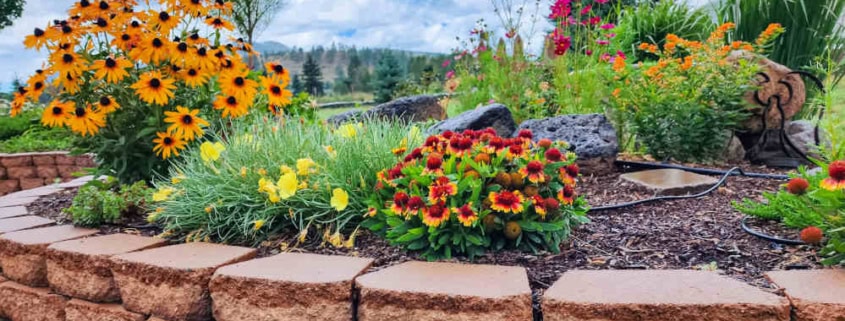

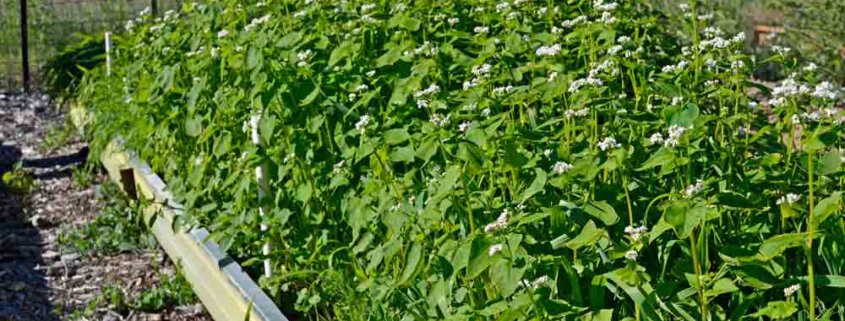 2019 Terroir Seeds
2019 Terroir Seeds